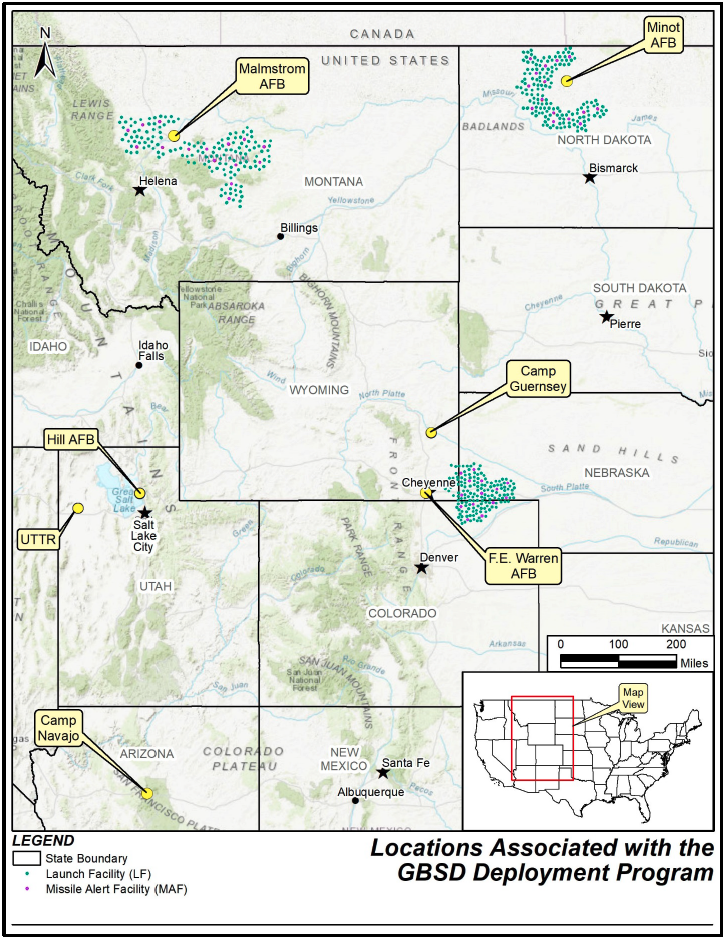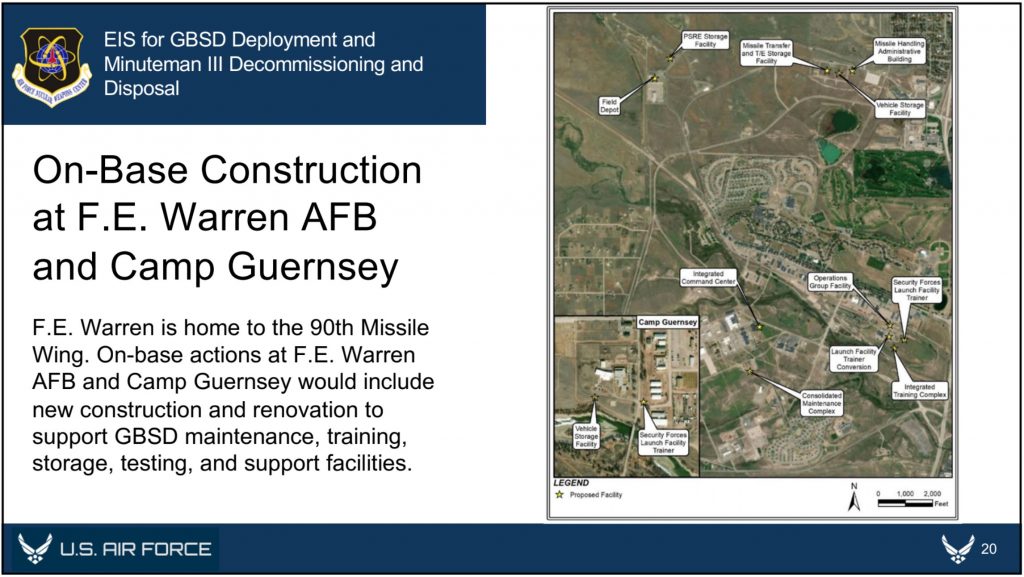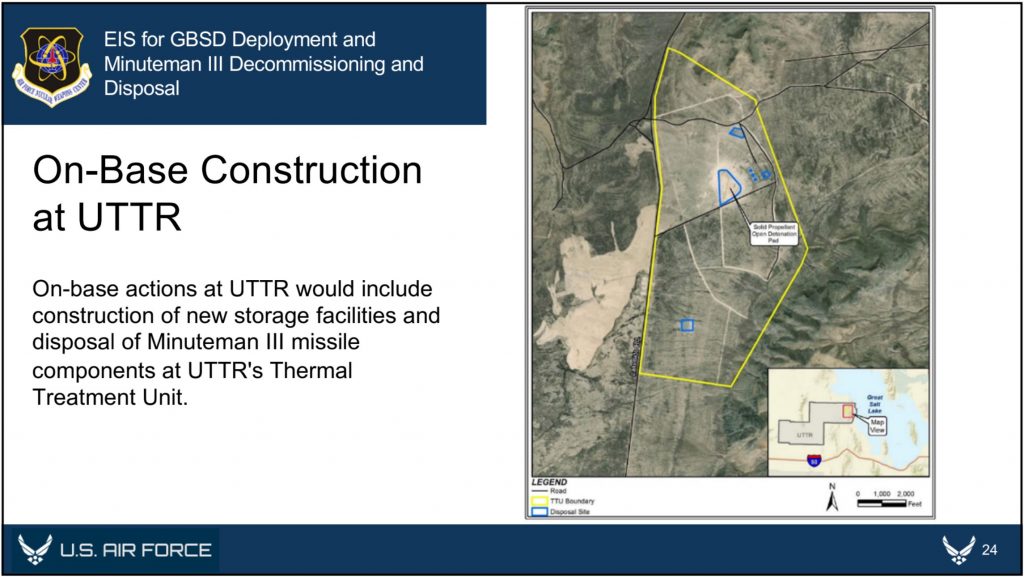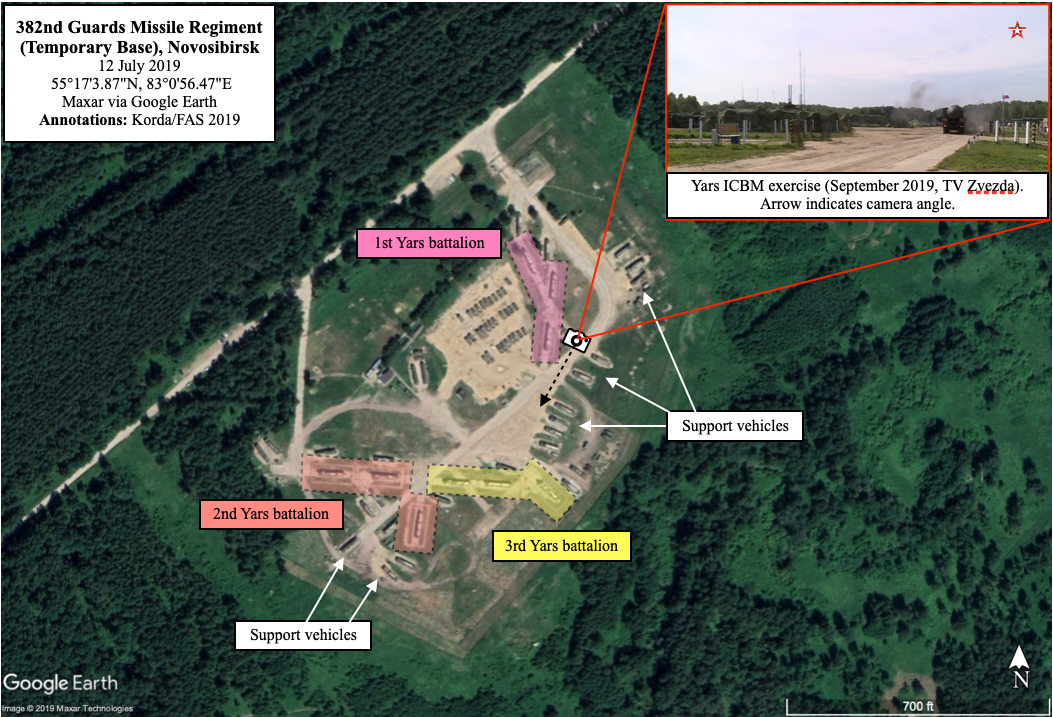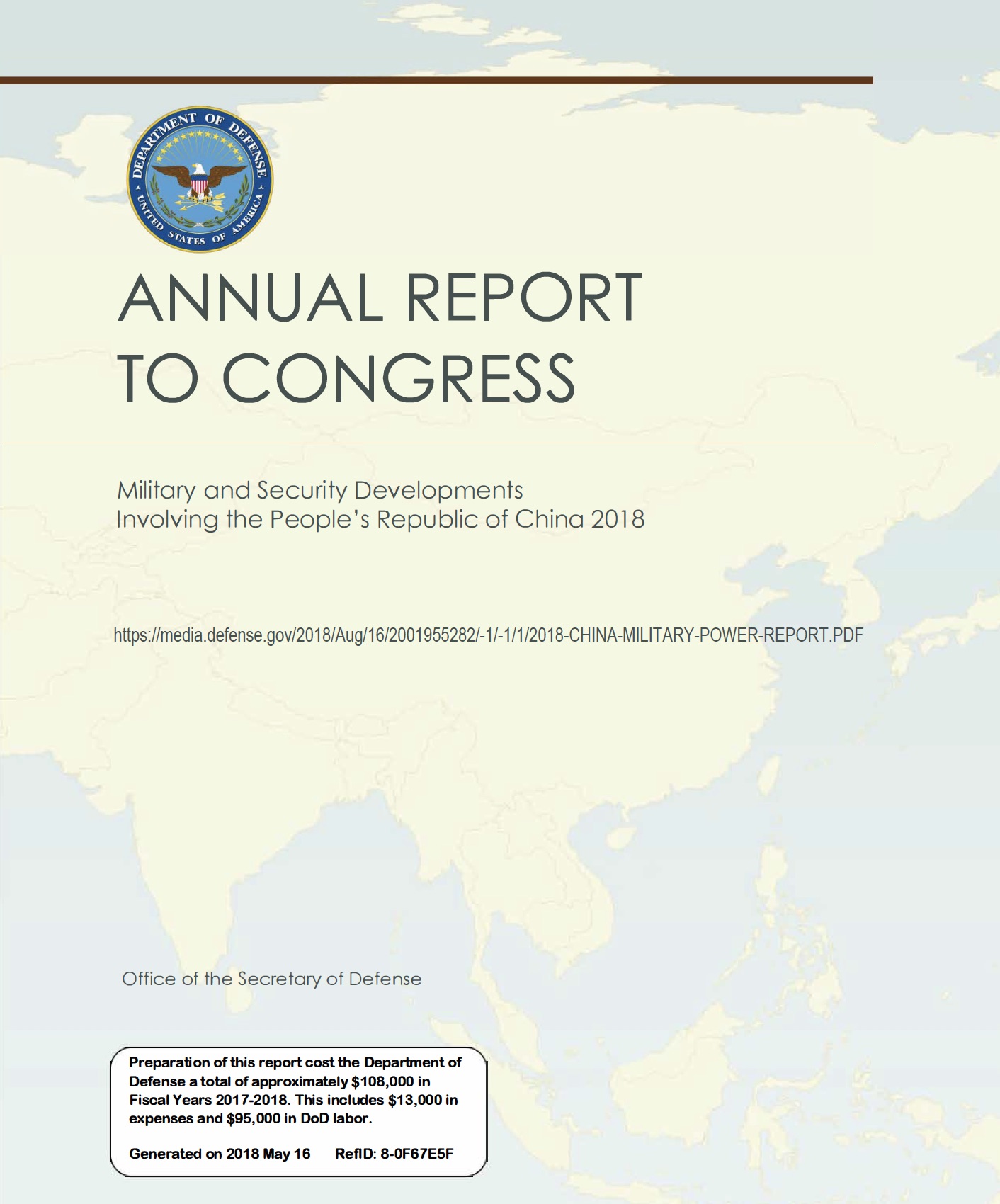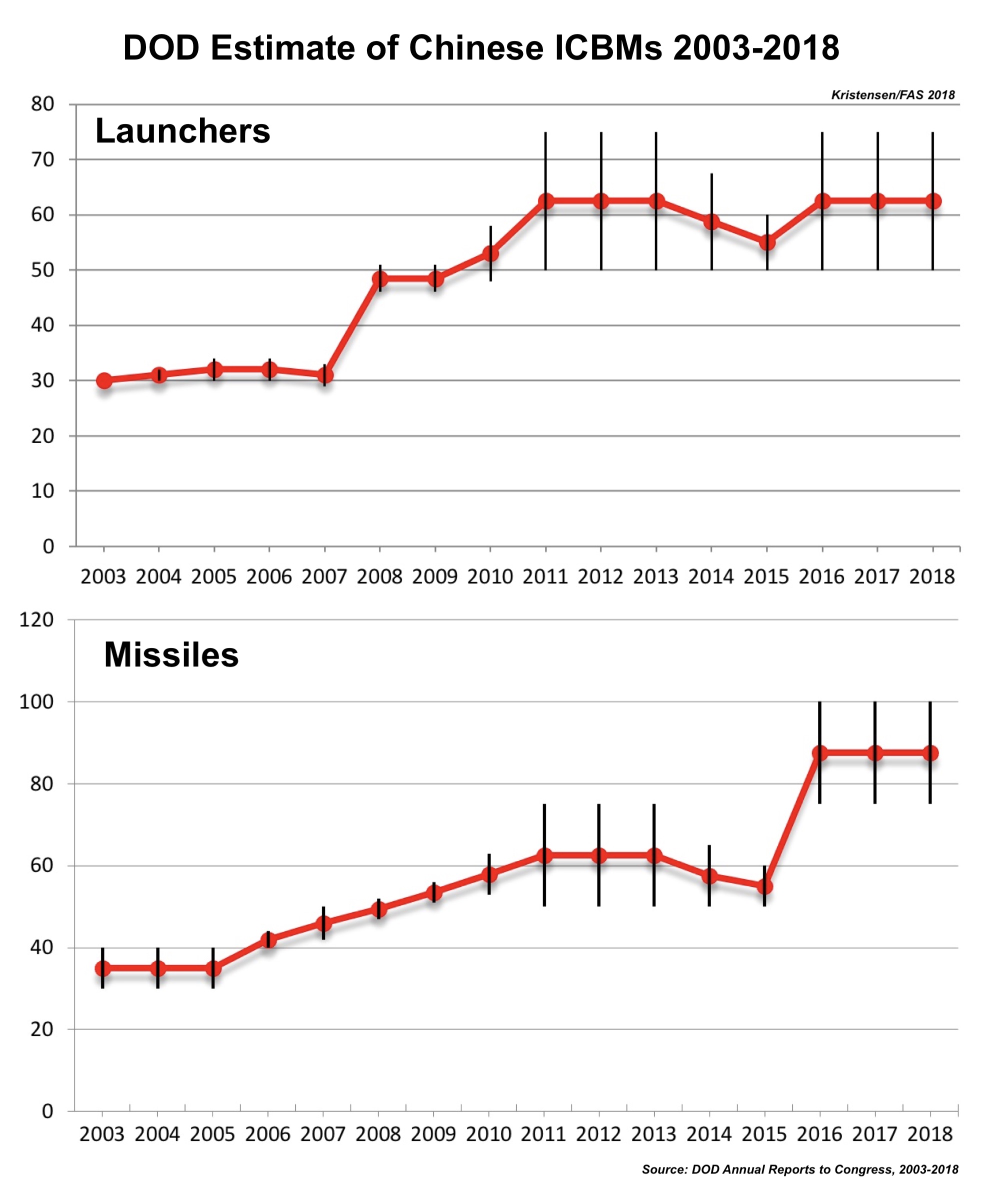Upgrade Underway for Russian Silos to Receive New Sarmat ICBM
New satellite imagery shows that preparations to deploy Russia’s new RS-28 Sarmat (SS-29) intercontinental ballistic missile (ICBM) are well underway.
However, the imagery also indicates that President Putin’s claims of deployment “in the near future” may be too optimistic. It is potentially possible that one or two missiles could be deployed early, but major construction is still ongoing at many of the silos in the first regiment and has not yet begun at all of them, and the completion of construction at all eventual Sarmat regiments may be over a decade away.
The Sarmat––which was originally scheduled to enter service between 2018 and 2020 and will replace Russia’s aging RS-20V Voevoda (SS-18) ICBM––had been subject to significant manufacturing, production, and testing delays. In January 2022, the “War Bolts” Telegram channel reported that flight tests for Sarmat had been postponed due to problems with the missile’s command module. Following Sarmat’s eventual first test flight on 20 April 2022, Putin announced that the new ICBM would enter combat duty by the end of the year. As of October 2023, however, only one additional Sarmat flight test had reportedly taken place (in February 2023) and, according to US officials, likely ended in failure.
Despite the lack of successful tests, in November 2022 the General Director of the Makeyev Rocket Design Bureau––responsible for the design of Sarmat––claimed that the missile had already entered serial production. On 1 September 2023, Roscosmos Chief Yury Borisov announced that Sarmat had “assumed combat alert posture,” although this was likely premature: on 5 October 2023, President Putin noted during his speech at the Valdai Club that some “administrative and bureaucratic procedures” still needed to be carried out before Sarmat could be placed on combat duty, and on 7 October 2023, the Russian Ministry of Defence noted on Telegram that the “final stages” of construction and installation were still underway at the first launch facilities and associated command post.
New satellite imagery indicates construction is well underway at the first regiment of the 62nd Missile Division near Uzhur in south Siberia. It is expected that a total of 46 Sarmat missiles will eventually be deployed with seven regiments (six missiles per regiment, plus one 10-missile regiment) in two divisions at Uzhur and Dombarovsky.
The first missile regiment undergoing its upgrade to Sarmat is the 302nd Missile Regiment and consists of six silos. Major construction continues at the launch control center and its accompanying silo (12C) and three other silos (13C, 15C, and 17C). The two remaining silos (16C and 18C) have only received minor upgrades and will take many months to complete if scheduled for the same comprehensive upgrade as the other silos.
Silos 12C and 17C:
The first two silos to begin their upgrades were Silos 12C (55.1144°, 89.6344°) and 17C (55.0347°, 89.7286°), which began their upgrades in the spring and summer of 2021, respectively. Over the past two years, the perimeters at both sites were removed, reshaped, and expanded with additional layers of fencing. The surface area of both silos has nearly doubled in size: Silo 12C has been expanded from approximately 0.228 square kilometers to 0.427 square kilometers, and the area of Silo 17C has been expanded from approximately 0.082 square kilometers to 0.136 square kilometers.

As of mid-September, construction appeared to be nearly complete inside the inner silo areas at both sites. The launch control center at Silo 12C has been upgraded to a newer LCC design that can also be seen at other Russian ICBM complexes, including the SS-27 Mod 1 “Topol-M” silo field near Tatishchevo, the SS-27 Mod 2 “Yars” silo field near Kozelsk, and the SS-19 Mod 4 “Avangard” silo field near Dombarovsky. In addition, Silo 12C boasts a new gun turret placement and expanded administrative area, although this outer area is not yet complete.
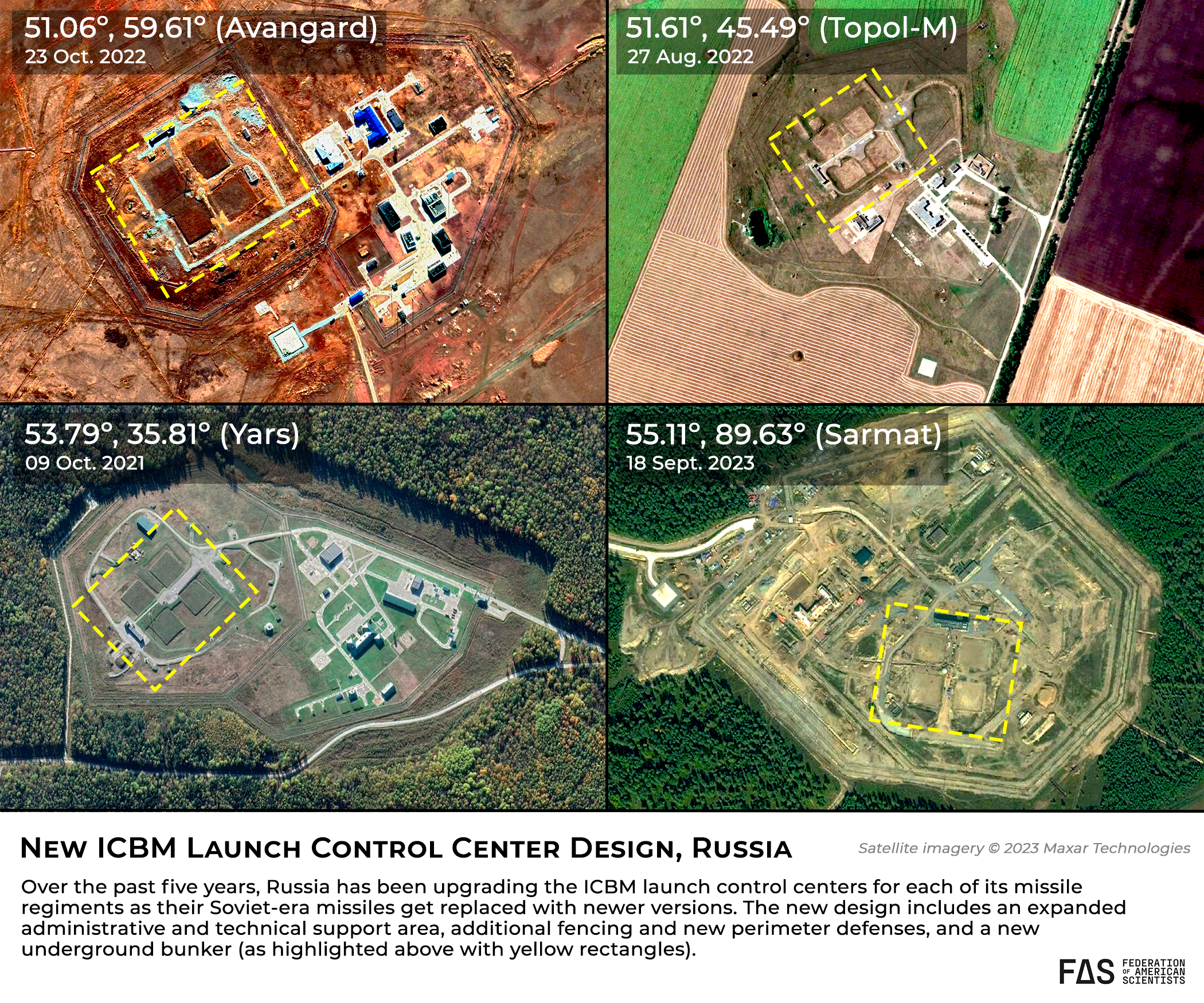
Notably, the immediate area surrounding Silo 17C has been subject to significant wildfire damage in the past. In 2017, a wildfire burned through all three sets of perimeter fencing and damaged the inner road leading to the silo hatch. In May 2021, another wildfire again burned through the three layers of fencing and appeared to damage an administrative building near the hatch.
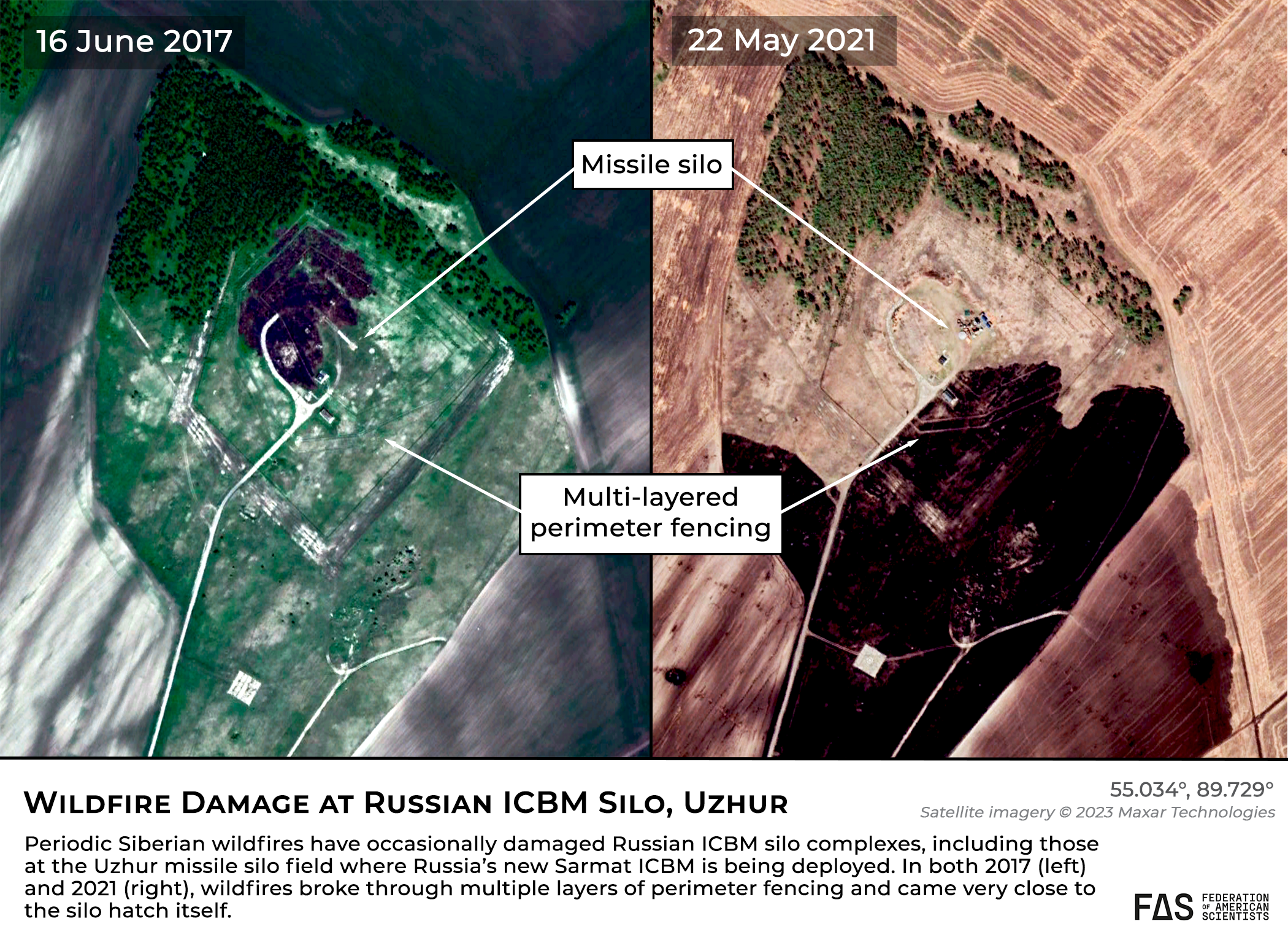
Silos 13C and 15C:
Silos 13C (55.2008°, 89.7061°) and 17C (55.0822°, 89.8155°) began their upgrades in late-2022, nearly 1.5 years after construction on the first two silos began. As of mid-October 2023, significant construction at both sites was still underway, including underground and inside the silos themselves. Trees have been removed at both sites to make space for the expanded perimeter fences. While the new perimeters at both sites have been marked out, the multiple layers of fencing have not yet been completed. New gun turrets at both sites now appear to be in place.

Use the Planet Labs PBC interactive slider to compare before/after images.
Silos 16C and 18C:
As of mid-September 2023, full-site construction at Silos 16C (55.0247º, 89.5711º) and 18C (54.9501º, 89.6833º) had not yet begun, although some silo maintenance work has been visible since mid-2021, possibly in preparation for the full-site construction.
Open silos
It is notable that satellites have managed to capture images of all four silos currently under construction with their hatches open; on more than one occasion, multiple different silos could be seen with their hatches open on the same day, and in some cases hatches have stayed open for days at a time. This suggests that operations to upgrade the silos themselves and preparations to deploy Sarmat ICBMs inside them––as touted by high-ranking Russian officials––are well underway.

Additional information:
• Nuclear Notebook: Russian Nuclear Weapons, 2023
This research was carried out with generous contributions from the New-Land Foundation, Ploughshares Fund, the Prospect Hill Foundation, Longview Philanthropy, and individual donors.
STRATCOM Says China Has More ICBM Launchers Than The United States – We Have Questions
In early-February 2023, the Wall Street Journal reported that U.S. Strategic Command (STRATCOM) had informed Congress that China now has more launchers for Intercontinental Ballistic Missiles (ICBMs) than the United States. The report is the latest in a serious of revelations over the past four years about China’s growing nuclear weapons arsenal and the deepening strategic competition between the world’s nuclear weapon states. It is important to monitor China’s developments to understand what it means for Chinese nuclear strategy and intensions, but it is also important to avoid overreactions and exaggerations.
First, a reminder about what the STRATCOM letter says and does not say. It does not say that China has more ICBMs or warheads on them than the United States, or that the United States is at an overall disadvantage. The letter has three findings (in that order):
- The number of ICBMs in the active inventory of China has not exceeded the number of ICBMs in the active inventory of the United States.
- The number of nuclear warheads equipped on such missiles of China has not exceeded the number of nuclear warheads equipped on such missiles of the United States.
- The number of land-based fixed and mobile ICBM launchers in China exceeds the number of ICBM launchers in the United States.
It is already well-known that China is building several hundred new missile silos. We documented many of them (see here, here and here), as did other analysts (here and here). It was expected that sooner or later some of them would be completed and bring China’s total number of ICBM launchers (silo and road-mobile) above the number of US ICBM launchers. That is what STRATCOM says has now happened.
STRATCOM ICBM Counting
The number of Chinese ICBM launchers included in the STRATCOM report to Congress was counted at a cut-off date of October 2022. It is unclear precisely how STRATCOM counts the Chinese silos, but the number appears to include hundreds of silos that were not yet operational with missiles at the time. So, at what point in its construction process did STRATCOM include a silo as part of the count? Does it have to be completely finished with everything ready except a loaded missile?
We have examined satellite photos of every single silo under construction in the three new large missile silo fields (Hami, Julin, and Yumen). It is impossible to determine with certainty from a satellite photo if a silo is completely finished, much less whether it is loaded with a missile. However, the available images indicate it is possible that most of the silos at Hami might have been complete by October 2022, that many of the silos at the Yumen field were still under construction, and that none of the silos at the Julin (Ordos) fields had been completed at the time of STRATCOM’s cutoff date (see image below).
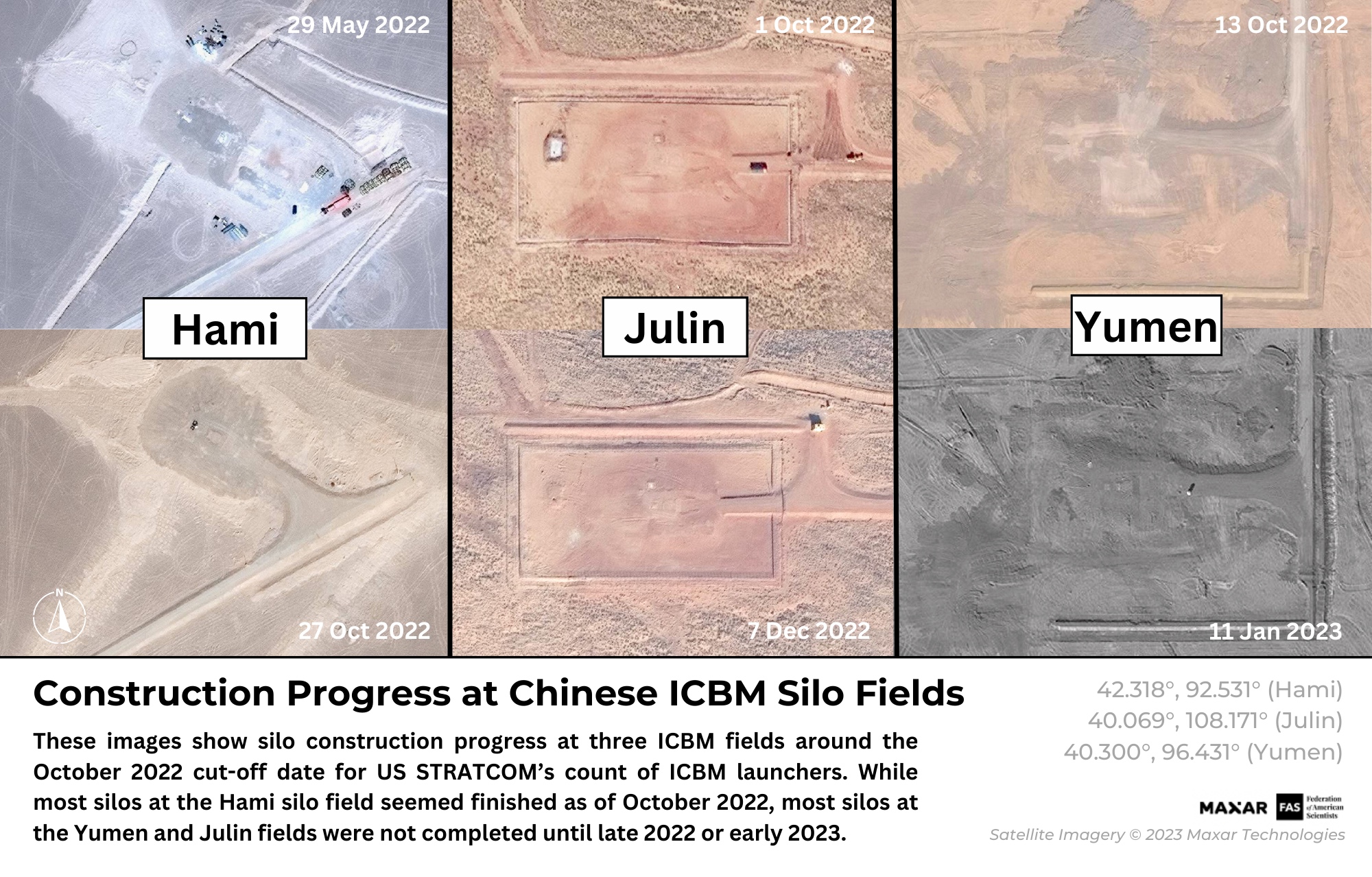
Commercial satellite images help assess STRATCOM claim about China’s missile silos.
The number of Chinese ICBM launchers reported by the Pentagon over the past three years has increased significantly from 100 launchers at the end of 2020, to 300 launchers at the end of 2021, to now more than 450 launchers as of October 2022. That is an increase of 350 launchers in only three years.
To exceed the number of US ICBM launchers as most recently reported by STRATCOM, China would have to have more than 450 launchers (mobile and silo) – the US Air Force has 400 silos with missiles and another 50 empty silos that could be loaded as well if necessary. Without counting the new silos under construction, we estimate that China has approximately 140 operational ICBM launchers with as many missiles. To get to 300 launchers with as many missiles, as the 2022 China Military Power Report (CMPR) estimated, the Pentagon would have to include about 160 launchers from the new silo fields – half of all the silos – as not only finished but with missiles loaded in them. We have not yet seen a missile loading – training or otherwise – on any of the satellite photos. To reach 450 launchers as of October 2022, STRATCOM would have to count nearly all the silos in the three new missile silo fields (see graph below).
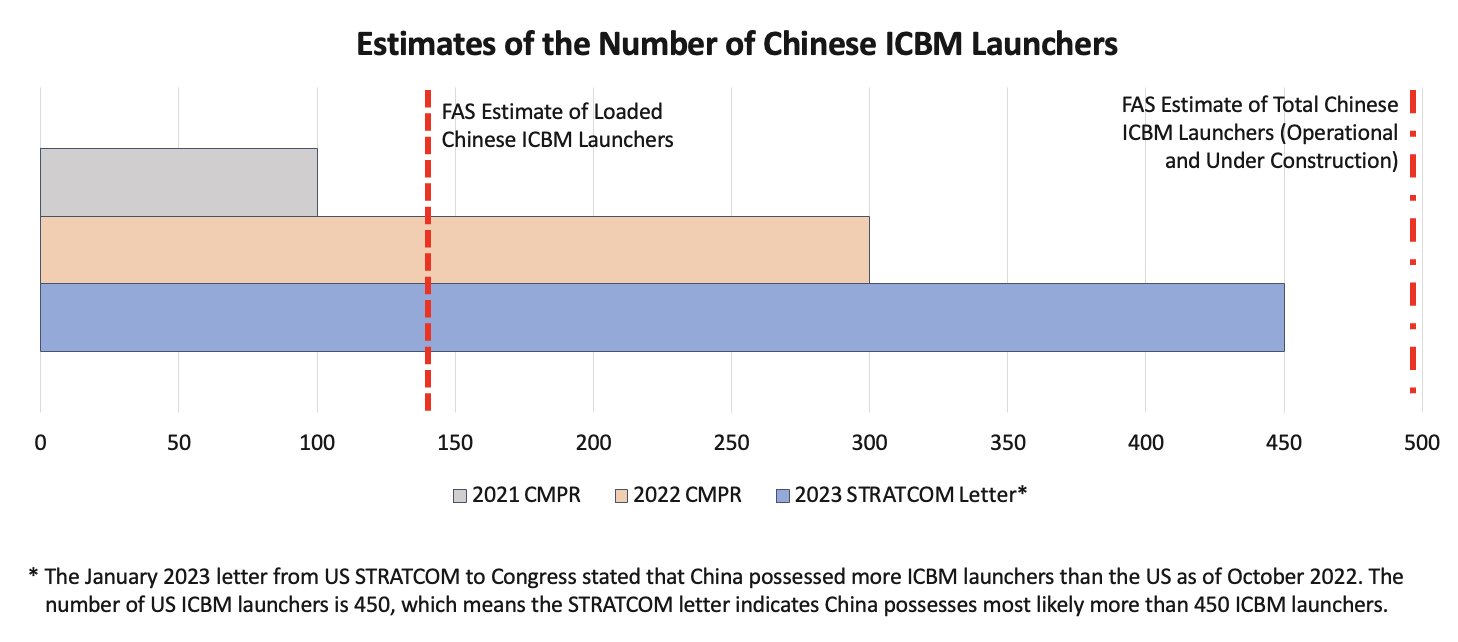
Pentagon estimates of Chinese completed ICBM launchers appear to include hundreds of new silos at three missile silo fields.
The point at which a silo is loaded with a missile depends not only on the silo itself but also on the operational status of support facilities, command and control systems, and security perimeters. Construction of that infrastructure is still ongoing at all the three missile silo fields.
It is also possible that the number of launchers and missiles in the Pentagon estimate is less directly linked. The number could potentially refer to the number of missiles for operational launchers plus missiles produced for launchers that have been more or less completed but not yet loaded with missiles.
All of that to underscore that there is considerable uncertainty about the operational status of the Chinese ICBM force.
However – in time for the Congressional debate on the FY2024 defense budget – some appear to be using the STRATCOM letter to suggest the United States also needs to increase its nuclear arsenal.
Comparing The Full Arsenals
The rapid increase of the Chinese ICBM force is important and unprecedented. Yet, it is also crucial to keep things in perspective. In his response to the STRATCOM letter, Rep. Mike Rogers – the new conservative chairman of the House Armed Services Committee – claimed that China is “rapidly approaching parity with the United States” in nuclear forces. That is not accurate.
Even if China ends up with more ICBMs than the United States and increases its nuclear stockpile to 1,500 warheads by 2035, as projected by the Pentagon, that does not give China parity. The United States has 800 launchers for strategic nuclear weapons and a stockpile of 3,700 warheads (see graph below).
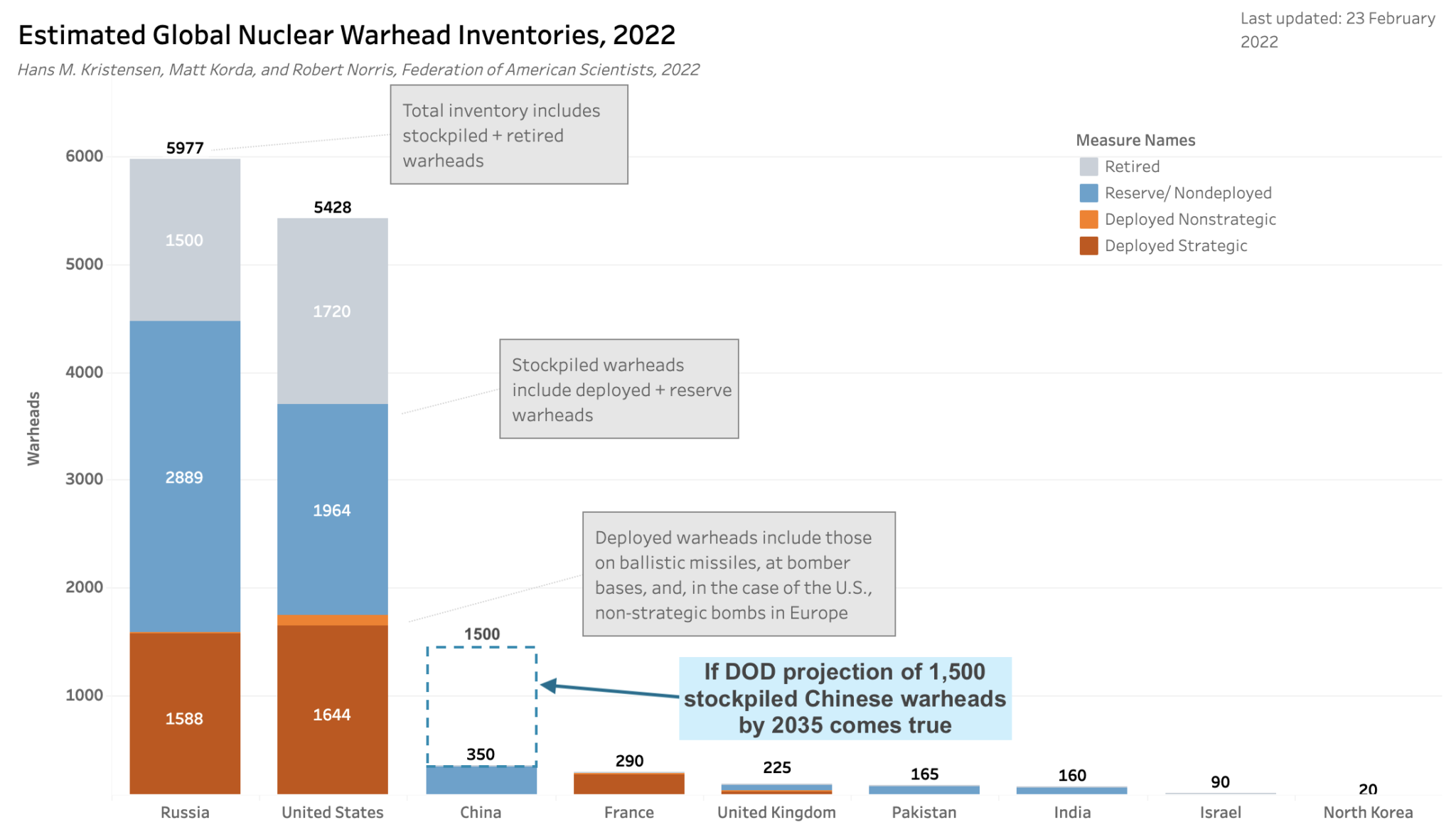
Even if China increases it nuclear weapons stockpile to 1,500 by 2035, it will only make up a fraction of the much larger US and Russian stockpiles.
The worst-case projection about China’s nuclear expansion assumes that it will fill everything with missiles with multiple warheads. In reality, it is unknown how many of the new silos will be filled with missiles, how many warheads each missile will carry, and how many warheads China can actually produce over the next decade.
The nuclear arsenals do not exist in a vacuum but are linked to the overall military capabilities and the policies and strategies of the owners.
The Political Dimension
STRATCOM initially informed Congress about its assessment that the number of Chinese ICBM launchers exceeded that of the United States back in November 2022. But the letter was classified, so four conservative members of the Senate and House armed services committees reminded STRATCOM that it was required to also release an unclassified version. They then used the unclassified letter to argue for more nuclear weapons stating (see screen shot of Committee web page below):
“We have no time to waste in adjusting our nuclear force posture to deter both Russia and China. This will have to mean higher numbers and new capabilities.” (Emphasis added.)
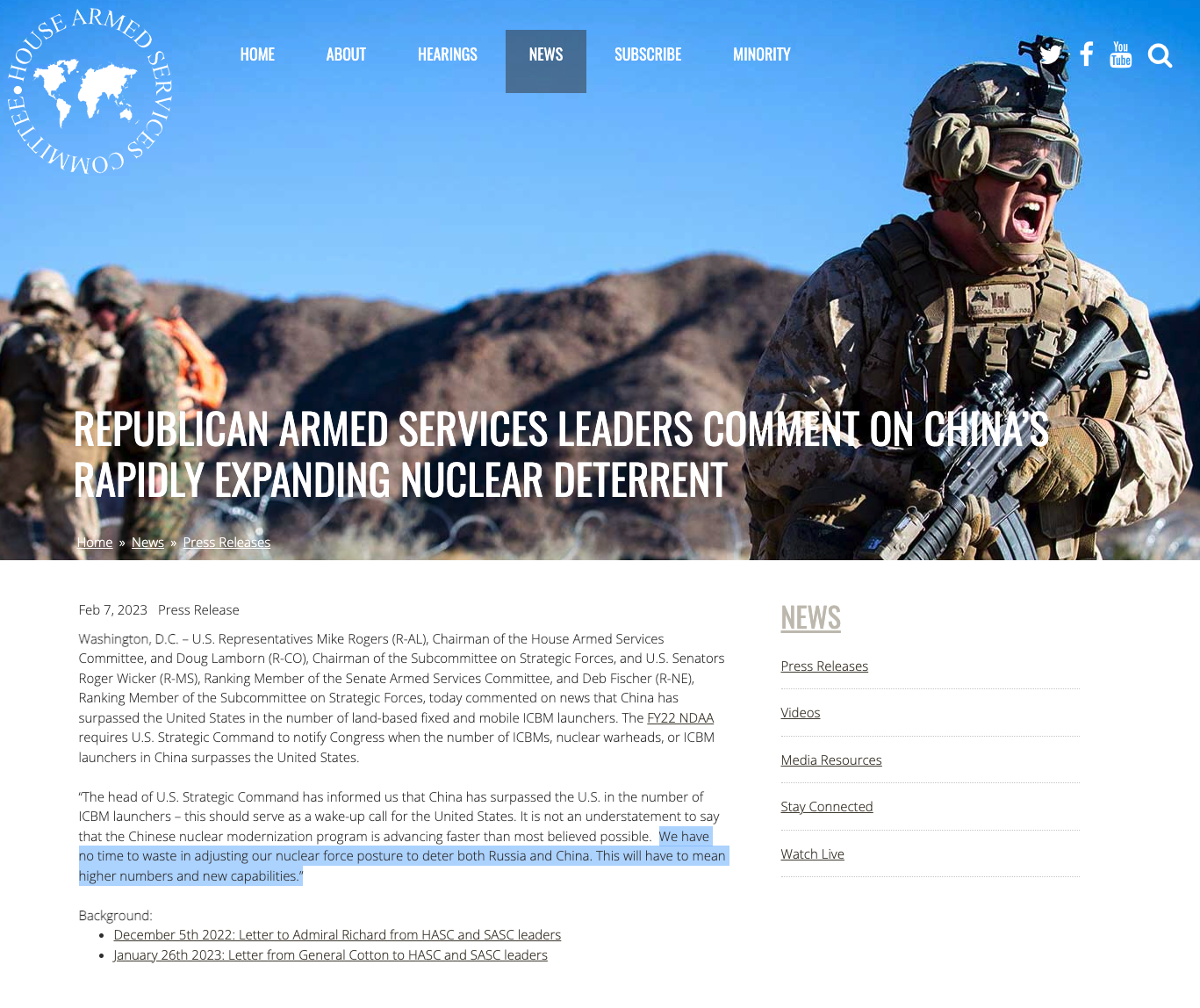
Lawmakers immediately used STRATCOM assessment of Chinese ICBM launchers to call for more US nuclear weapons.
Although defense contractors probably would be happy about that response, it is less clear why ‘higher numbers’ are necessary for US nuclear strategy. Increasing US nuclear weapons could in fact end up worsening the problem by causing China and Russia to increase their arsenals even further. And as we have already seen, that would likely cause a heightened demand for more US nuclear weapons.
We have seen this playbook before during the Cold War nuclear arms race. Only this time, it’s not just between the United States and the Soviet Union, but with Russia and a growing China.
Even before China will reach the force levels projected by the Pentagon, the last remaining arms control treaty with Russia – the New START Treaty – will expire in February 2026. Without a follow-on agreement, Russia could potentially double the number of warheads it deploys on its strategic launchers.
Even if the defense hawks in Congress have their way, the United States does not seem to be in a position to compete in a nuclear arms race with both Russia and China. The modernization program is already overwhelmed with little room for expansion, and the warhead production capacity will not be able to produce large numbers of additional nuclear weapons for the foreseeable future.
What the Chinese nuclear buildup means for Chinese nuclear policy and how the United States should respond to it (as well as to Russia) is much more complicated and important to address than a rush to get more nuclear weapons. It would be more constructive for the United States to focus on engaging with Russia and China on nuclear risk reduction and arms control rather than engage in a build-up of its nuclear forces.
Additional Information:
Status of World Nuclear Forces
This research was carried out with generous contributions from the John D. and Catherine T. MacArthur Foundation, the New-Land Foundation, Ploughshares Fund, the Prospect Hill Foundation, Longview Philanthropy, the Stewart R. Mott Foundation, the Future of Life Institute, Open Philanthropy, and individual donors.
If Arms Control Collapses, US and Russian Strategic Nuclear Arsenals Could Double In Size
On January 31st, the State Department issued its annual Report to Congress on the Implementation of the New START Treaty, with a notable––yet unsurprising––conclusion:
“Based on the information available as of December 31, 2022, the United States cannot certify the Russian Federation to be in compliance with the terms of the New START Treaty.”
This finding was not unexpected. In August 2022, in response to a US treaty notification expressing an intent to conduct an inspection, Russia invoked an infrequently used treaty clause “temporarily exempting” all of its facilities from inspection. At the time, Russia attempted to justify its actions by citing “incomplete” work regarding Covid-19 inspection protocols and perceived “unilateral advantages” created by US sanctions; however, the State Department’s report assesses that this is “false:”
“Contrary to Russia’s claim that Russian inspectors cannot travel to the United States to conduct inspections, Russian inspectors can in fact travel to the United States via commercial flights or authorized inspection airplanes. There are no impediments arising from U.S. sanctions that would prevent Russia’s full exercise of its inspection rights under the Treaty. The United States has been extremely clear with the Russian Federation on this point.”
Instead, the report suggests that the primary reason for suspending inspections “centered on Russian grievances regarding U.S. and other countries’ measures imposed on Russia in response to its unprovoked, full-scale invasion of Ukraine.”
Echoing the findings of the report, on February 1st, Cara Abercrombie, deputy assistant to the president and coordinator for defense policy and arms control for the White House National Security Council, stated in a briefing at the Arms Control Association that the United States had done everything in its power to remove pandemic- and sanctions-related limitations for Russian inspectors, and that “[t]here are absolutely no barriers, as far as we’re concerned, to facilitating Russian inspections.”
Nonetheless, Russia has still not rescinded its exemption and also indefinitely postponed a scheduled meeting of the Bilateral Consultative Commission in November. In a similar vein, this is believed to be tied to US support for Ukraine, as indicated by Deputy Foreign Minister Sergei Ryabkov who said that arms control “has been held hostage by the U.S. line of inflicting strategic defeat on Russia,” and that Russia was “ready for such a scenario” if New START expired without a replacement.
These two actions, according to the United States, constitute a state of “noncompliance” with specific clauses of New START. It is crucial to note, however, the distinction between findings of “noncompliance” (serious, yet informal assessments, often with a clear path to reestablishing compliance), “violation” (requiring a formal determination), and “material breach” (where a violation rises to the level of contravening the object or purpose of the treaty).
It is also important to note that the United States’ findings of Russian noncompliance are not related to the actual number of deployed Russian warheads and launchers. While the report notes that the lack of inspections means that “the United States has less confidence in the accuracy of Russia’s declarations,” the report is careful to note that “While this is a serious concern, it is not a determination of noncompliance.” The report also assesses that “Russia was likely under the New START warhead limit at the end of 2022” and that Russia’s noncompliance does not threaten the national security interests of the United States.
The high stakes of failure: worst-case force projections after New START’s expiry
Both the US and Russia have meticulously planned their respective nuclear modernization programs based on the assumption that neither country will exceed the force levels currently dictated by New START. Without a deal after 2026, that assumption immediately disappears; both sides would likely default to mutual distrust amid fewer verifiable data points, and our discourse would be dominated by worst case thinking about how both countries’ arsenals would grow in the future.
For an example of this kind of thinking, look no further than the new Chair of the House Armed Services Committee, who argued in response to the State Department’s findings of Russian noncompliance that “The Joint Staff needs to assume Russia has or will be breaching New START caps.” As previously mentioned, the State Department report explicitly states that they have only found Russia to be noncompliant on facilitating inspections and BCC meetings, not on deployed warheads and launchers.
It is clear that the longer that these compliance issues persist, the more they will ultimately hinder US-Russia negotiations over a follow-on treaty, which is necessary in order to continue the bilateral strategic arms control regime beyond New START’s expiry in February 2026. As Amb. Steve Pifer, non-resident Senior Fellow at the Brookings Institution, noted during the ACA webinar, “We have three years until New START expires. That seems like a lot of time, but it’s not a long of time if you’re going to try to do something ambitious.”
To that end, both sides should be clear-eyed about the stakes, and more specifically, about what happens if they fail to secure a new deal limiting strategic offensive arms.
The United States has a significant upload capacity on its strategic nuclear forces, where it can bring extra warheads out of storage and add them to the deployed missiles and bombers. Although all 400 deployed US ICBMs currently only carry a single warhead, about half of them use the Mk21A reentry vehicle that is capable of carrying up to three warheads each. Moreover, the United States has an additional 50 “warm” ICBM silos which could be reloaded with missiles if necessary. With these potential additions in mind, the US ICBM force could potentially more than double from 400 to 950 warheads.
In the absence of treaty limitations, the United States could also upload each of its deployed Trident SLBMs with a full complement of eight warheads, rather than the current average of four to five. Factoring in the small numbers of submarines that are assumed to be out for maintenance at any given time, then the United States could approximately double the number of warheads deployed on its SLBMs, to roughly 1,920. The United States could potentially also reactivate the four launch tubes on each submarine that it deactivated to meet the New START limit, thus adding 56 missiles with 448 warheads to the fleet. However, this possibility is not reflected in the table because it is unlikely that the United States would choose to reconstitute the additional four launch tubes on each submarine given their imminent replacement with the next-generation Columbia-class.
Either of these actions would likely take months to complete, particularly given the complexities involved with uploading additional warheads on ICBMs. Moreover, ballistic missile submarines would have to return to port on a rotating schedule in order to be uploaded with additional warheads. However, deploying additional warheads to US bomber bases could be done very quickly, and the United States could potentially upload nearly 700 cruise missiles and bombs on its B-52 and B-2 bombers.
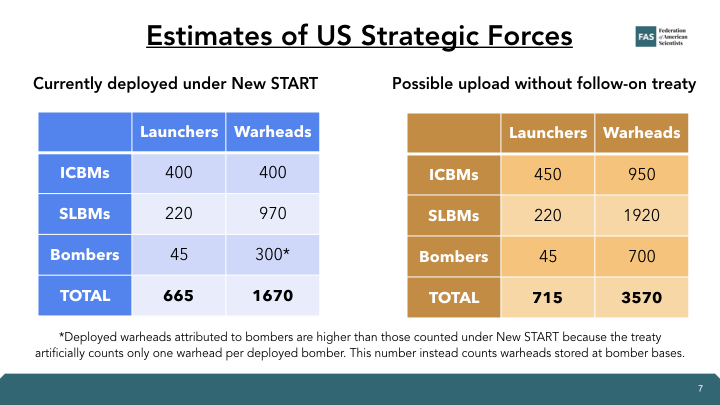
[Note: These numbers are projections based off of estimates; they are not predictions or endorsements. They also do not take into account how the number of available launchers and warheads will change when ongoing modernization programs are eventually completed, as this is unlikely to occur before New START’s expiry in 2026]
Russia also has a significant upload capacity, especially for its ICBMs. Several of Russia’s existing ICBMs are thought to have been downloaded to a smaller number of warheads than their maximum capacities, in order to meet the New START force limits. As a result, without the limits imposed by New START, Russia’s ICBM force could potentially increase from approximately 834 warheads to roughly 1,197 warheads.
Warheads on submarine-launched ballistic missiles onboard some of Russia’s SSBNs are also thought to have been reduced to a lower number to meet New START limits. Without these limitations, the number of deployed warheads could potentially be increased from an estimated 640 to approximately 832 (also with a small number of SSBNs assumed to be out for maintenance). As in the US case, Russian bombers could be loaded relatively quickly with hundreds of nuclear weapons. The number is highly uncertain but assuming approximately 50 bombers are operational, the number of warheads could potentially be increased to nearly 600.
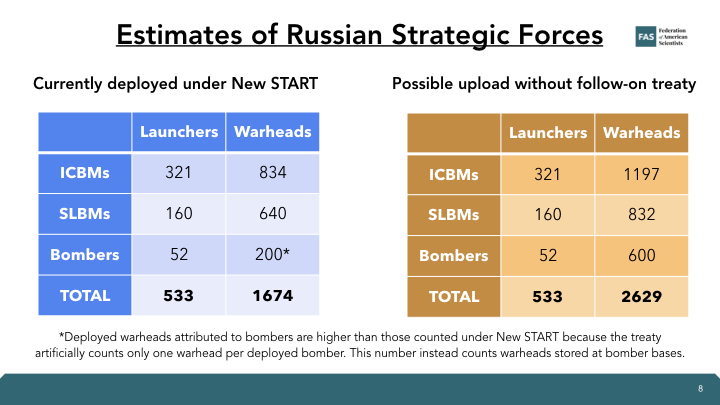
Slide showing estimates of Russian strategic forces, as well as a projection showing the possible upload without a follow-on treaty. Numbers mirror those found in the article text.
Combined, if both countries uploaded their delivery systems to accommodate the maximum number of possible warheads, both sets of arsenals would approximately double in size. The United States would have more deployable strategic warheads but Russia would still have a larger total arsenal of operational nuclear weapons, given its sizable stockpile of nonstrategic nuclear warheads which are not treaty-accountable.
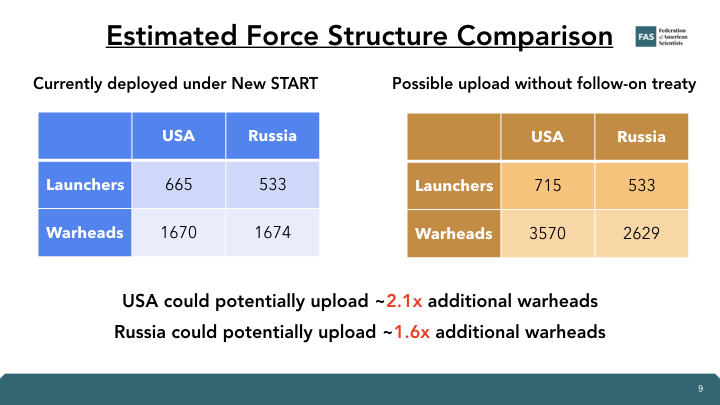
Slide showing comparison estimates of US and Russian strategic forces, as well as a projection showing the possible upload without a follow-on treaty. Numbers mirror those found in the article text.
Moreover, there are expected consequences beyond the offensive strategic nuclear forces that New START regulates. If the verification regime and data exchanges elapse, both countries are likely to enhance their intelligence capabilities to make up for the uncertainty regarding the other side’s nuclear forces. Both countries are also likely to invest more into what they perceive will increase their overall military capabilities, such as conventional missile forces, nonstrategic nuclear forces, and missile defense.
These moves could trigger reactions in other nuclear-armed states, some of whom might also decide to increase their nuclear forces and the role they play in their military strategies. In particular, it is becoming increasingly clear that China appears to no longer be satisfied with just a couple hundred nuclear weapons to ensure its security, and in a shift from longstanding doctrine, may now be looking to size its own nuclear force closer to the size of the US and Russian deployed nuclear forces.
Some US former defense officials have suggested that the United States needs to increase its deployed nuclear force to compensate for the increased nuclear arsenal that China is already building and an alleged increase in Russian non-strategic nuclear weapons––either by negotiating a higher treaty limit with Russia or withdrawing from the New START treaty.
But doing so would not solve the problem and could put the United States on a path where it would in fact face even greater numbers of Russian and Chinese nuclear weapons in the future. A higher treaty warhead limit would obviously increase – not reduce – the number of Russian warheads aimed at the United States; and pulling out of New START would likely cause Russia to deploy even more weapons. Moreover, a significant increase in the size of US and Russian deployed nuclear forces could cause China to increase its arsenal even further. Such developments could subsequently have ripple effects for India, Pakistan, and elsewhere – developments that would undermine, rather than improve, US and international security.
Uploading more warheads is not necessary to maintain deterrence
It is important to note that even if such worst-case scenarios were to occur, in the past the Department of Defense and the Director of National Intelligence have assessed that even a significant Russian increase of deployed nuclear warheads would not have a deleterious effect on US deterrence capabilities. A 2012 joint study assessed:
“[E]ven if significantly above the New START Treaty limits, [Russia’s deployment of additional nuclear warheads] would have little to no effect on the U.S. assured second-strike capabilities that underwrite our strategic deterrence posture. The Russian Federation, therefore, would not be able to achieve a militarily significant advantage by any plausible expansion of its strategic nuclear forces, even in a cheating or breakout scenario under the New START Treaty, primarily because of the inherent survivability of the planned U.S. strategic force structure, particularly the OHIO-class ballistic missile submarines, a number of which are at sea at any given time.”
Although the political situation has dramatically changed over the past decade since the study was published, this particular deterrence dynamic has not. The United States’ second-strike capabilities remain as secure today––even among Russia’s noncompliance and China’s nuclear buildup––as they did a decade ago. As a result, it seems clear that although uploading additional warheads onto US systems may seem like a politically strong response, it would not offer the United States any additional advantage that it does not already possess, and would likely trigger developments that would not be in its national security interest.
—
Background Information:
- “The Long View: Strategic Arms Control After the New START Treaty,” FAS Nuclear Notebook, Bulletin of the Atomic Scientists, November 2022.
- “United States nuclear weapons, 2023,” FAS Nuclear Notebook, Bulletin of the Atomic Scientists, January 2023.
- “Russian nuclear weapons, 2022,” FAS Nuclear Notebook, Bulletin of the Atomic Scientists, February 2022.
- Status of World Nuclear Forces, Federation of American Scientists
This research was carried out with generous contributions from the John D. and Catherine T. MacArthur Foundation, the New-Land Foundation, Ploughshares Fund, the Prospect Hill Foundation, Longview Philanthropy, the Stewart R. Mott Foundation, the Future of Life Institute, Open Philanthropy, and individual donors.
New Environmental Assessment Reveals Fascinating Alternatives to Land-Based ICBMs
A new Air Force environmental assessment reveals that it considered basing ICBMs in underground railway tunnels––or possibly underwater.

Map of the ICBM missile fields contained within the Air Force’s July 2022 assessment.
On July 1st, the Air Force published its Draft Environmental Impact Statement (EIS) for its proposed ICBM replacement program, previously known as the Ground-Based Strategic Deterrent (GBSD) and now by its new name, “Sentinel.” The government typically conducts an EIS whenever a federal program could potentially disrupt local water supplies, transportation, socioeconomics, geology, air quality, and other related factors.
A comprehensive environmental assessment is certainly warranted in this case, given the tremendous scale of the Sentinel program––which consists of a like-for-like replacement of all 400 Minuteman III missiles that are currently deployed across Colorado, Montana, Nebraska, North Dakota, and Wyoming, plus upgrades to the launch facilities, launch control centers, and other supporting infrastructure.

Cover page of the Air Force’s July 2022 Draft Environmental Impact Statement for the GBSD.
The Draft EIS was anxiously awaited by local stakeholders, chambers of commerce, contractors, residents, and… me! Not because I’m losing sleep about whether Sentinel construction will disturb Wyoming’s Western Bumble Bee (although maybe I should be!), but rather because an EIS is also a wonderful repository for juicy, and often new, details about federal programs––and the Sentinel’s Draft EIS is certainly no exception.
Interestingly, the most exciting new details are not necessarily about what the Air Force is currently planning for the Sentinel, but rather about which ICBM replacement options they previously considered as alternatives to the current program of record. These alternatives were assessed during in the Air Force’s 2014 Analysis of Alternatives––a key document that weighs the risks and benefits of each proposed action––however, that document remains classified. Therefore, until they were recently referenced in the July 2022 Draft EIS, it was not clear to the public what the Air Force was actually assessing as alternatives to the current Sentinel program.
Missile alternatives
The Draft EIS notes that the Air Force assessed four potential missile alternatives to the current plan, which involves designing a completely new ICBM:
- Reproducing Minuteman III ICBMs to “existing specifications” by washing out and refilling the first- and second-stage rocket boosters; remanufacturing the third stages and Propulsion System Rocket Engine––the ICBM’s post-boost vehicle; and refurbishing and replacing all other subsystems;
The Air Force appears to have ultimately eliminated all four of these options from consideration because they did not meet all of their “selection standards,” which included criteria like sustainability, performance, safety, riskiness, and capacity for integration into existing or proposed infrastructure.
Of particular interest, however, is the Air Force’s note that the Minuteman III reproduction alternative was eliminated in part because it did not “meet the required performance criteria for ICBMs in the context of modern and evolving threats (e.g., range, payload, and effectiveness.” It is highly significant to state that the Minuteman III cannot meet the required performance criteria for ICBMs, given that the Minuteman III currently performs the ICBM role for the US Air Force and will continue to do so for the next decade.
This statement also suggests that “modern and evolving threats” are driving the need for an operationally improved ICBM; however, it is unclear what the Air Force is referring to, or how these threats would necessarily justify a brand-new ICBM with new capabilities. As I wrote in my March 2021 report, “Siloed Thinking: A Closer Look at the Ground-Based Strategic Deterrent,”
“With respect to US-centric nuclear deterrence, what has changed since the end of the Cold War? China is slowly but steadily expanding its nuclear arsenal and suite of delivery systems, and North Korea’s nuclear weapons program continues to mature. However, the range and deployment locations of the US ICBM force would force the missiles to fly over Russian territory in the event that they were aimed at Chinese or North Korean targets, thus significantly increasing the risk of using ICBMs to target either country. Moreover, […] other elements of the US nuclear force––especially SSBNs––could be used to accomplish the ICBM force’s mission under a revised nuclear force posture, potentially even faster and in a more flexible manner. […] It is additionally important to note that even if adversarial missile defenses improved significantly, the ability to evade missile defenses lies with the payload––not the missile itself. By the time that an adversary’s interceptor was able to engage a US ICBM in its midcourse phase of flight, the ICBM would have already shed its boosters, deployed its penetration aids, and would be guided solely by its reentry vehicle. Reentry vehicles and missile boosters can be independently upgraded as necessary, meaning that any concerns about adversarial missile defenses could be mitigated by deploying a more advanced payload on a life-extended Minuteman III ICBM.”
Of additional interest is the passage explaining why the Air Force dismissed the possibility of using the Trident II D5 SLBM as a land-based weapon:
“The D5 is a high-accuracy weapon system capable of engaging many targets simultaneously with overall functionality approaching that of land- based missiles. The D5 represents an existing technology, and substantial design and development cost savings would be realized; but the associated savings would not appreciably offset the infrastructure investment requirements (road and bridge enhancements) necessary to make it a land-based weapon system. In addition, motor performance and explosive safety concerns undermine the feasibility of using the D5 as a land-based weapon system.”
The Air Force’s concerns over road and bridge quality are probably justified––missiles are incredibly heavy, and America’s bridges are falling apart at a terrifying rate. However, it is unclear why the Air Force is not confident about the D5’s motor performance, given that even aging Trident SLBMs have performed very well in recent flight tests: in 2015 the Navy conducted a successful Trident flight test using “the oldest 1st stage solid rocket motor flown to date” (over 26 years old), with 2nd and 3rd stage motors that were 22 years old. In January 2021, Vice Admiral Johnny Wolfe Jr.––the Navy’s Director for Strategic Systems Programs––remarked that “solid rocket motors, the age of those we can extend quite a while, we understand that very well.” This is largely due to the Navy’s incorporation of nondestructive testing techniques––which involve sending a probe into the bore to measure the elasticity of the propellant––to evaluate the reliability of their missiles.
As a result, the Navy is not currently contemplating the purchase of a brand-new missile to replace its current arsenal of Trident SLBMs, and instead plans to conduct a second life-extension to keep them in service until 2084. However, the Air Force’s comments suggest either a lack of confidence in this approach, or perhaps an institutional preference towards developing an entirely new missile system. [Note: Amy Woolf helpfully offered up another possible explanation, that the Air Force’s concerns could be related to the ability of the Trident SLBM’s cold launch system to perform effectively on land, given that these very different launch conditions could place additional stress on the missile system itself.]
Basing alternatives
The Draft EIS also notes that the Air Force assessed two fascinating––and somewhat familiar––alternatives for basing the new missiles: in underground tunnels and in “deep-lake silos.”
The tunnel option––which had been teased in previous programmatic documents but never explained in detail––would include “locating, designing, excavating, developing, and installing critical support infrastructure such as rail systems and [launch facilities] for an array of underground tunnels that would likely span hundreds of miles”––and it is effectively a mashup of two concepts from the late Cold War.
The rail concept was strongly considered during the development of the MX missile in the 1980s, although the plan called for missile trains to be dispersed onto the country’s existing civilian rail network, rather than into newly-built underground tunnels. Both the rail and tunnel concepts were referenced in one of my favourite Pentagon reports––a December 1980 Pentagon study called “ICBM Basing Options,” which considered 30 distinct and often bizarre ICBM basing options, including dirigibles, barges, seaplanes, and even hovercraft!

Illustrations of “Commercial Rail” concept from 1980 Pentagon report, “ICBM Basing Options.”
The second option––basing ICBMs in deep-lake silos––was also referenced in that same December 1980 study. The concept––nicknamed “Hydra”––proposed dispersing missiles across the ocean using floating silos, with “only an inconspicuous part of the missile front end [being] visible above the surface.” Interestingly, this raises the theoretical question of whether the Air Force would still maintain control over the ICBM mission, given that the missiles would be underwater.

Illustration of “Hydra” concept from 1980 Pentagon report, “ICBM Basing Options.”
When considering alternative basing modes for the Sentinel ICBM, the Air Force eliminated both concepts due to cost prohibitions, and, in the case of underwater basing, a lack of confidence that the missiles would be safe and secure. This concern was also floated in the 1980 study as well, with the Pentagon acknowledging the likelihood that US adversaries and non-state actors “would also be engaged in a hunt for the Hydras. Not under our direct control, any missile can be destroyed or towed away (stolen) at leisure.”
Another potential option?
In addition to revealing these fascinating details about previously considered alternatives to the Sentinel program, the Draft EIS also highlighted a public comment suggesting that “the most environmentally responsible option” would simply be the reduction of the Minuteman III inventory.
The Air Force rejected the comment because it says that it is “required by law to accelerate the development, procurement, and fielding of the ground based strategic deterrent program;’” however, the public commenter’s suggestion is certainly a reasonable one. The current force level of 400 deployed ICBMs is not––and has never been––a magic number, and it could be reduced further for a variety of reasons, including those related to security, economics, or a good faith effort to reduce deployed US nuclear forces. In particular, as George Perkovich and Pranay Vaddi wrote in a 2021 Carnegie Endowment for International Peace report, “This assumption that the ICBM force would not be eliminated or reduced before 2075 is difficult to reconcile with U.S. disarmament obligations under Article VI of the Nuclear Non-Proliferation Treaty.”
The security environment of the 21st century is already very different than that of the previous century. The greatest threats to Americans’ collective safety are non-militarized, global phenomena like climate change, domestic unrest and inequality, and public health crises. And recent polling efforts by ReThink Media, the Union of Concerned Scientists, and the Federation of American Scientists suggest that Americans overwhelmingly want the government to invest in more proximate social issues, rather than on nuclear weapons. To that end, rather than considering building new missile tunnels, it would likely be much more domestically popular to spend money on domestic priorities––perhaps new subway tunnels?
—
Background Information:
- “Siloed Thinking: A Closer Look at the Ground-Based Strategic Deterrent,” Federation of American Scientists (Mar. 2021)
- “Environmental Assessment Reveals New Details About the Air Force’s ICBM Replacement Plan,” Federation of American Scientists (Nov. 2020)
- ICBM Information Project, Federation of American Scientists
This publication was made possible by generous support from the John D. and Catherine T. MacArthur Foundation, the New-Land Foundation, Ploughshares Fund, the Prospect Hill Foundation, and Longview Philanthropy. The statements made and views expressed are solely the responsibility of the author.
Environmental Assessment Reveals New Details About the Air Force’s ICBM Replacement Plan
Any time a US federal agency proposes a major action that “has the potential to cause significant effects on the natural or human environment,” they must complete an Environmental Impact Statement, or EIS. An EIS typically addresses potential disruptions to water supplies, transportation, socioeconomics, geology, air quality, and other factors in great detail––meaning that one can usually learn a lot about the scale and scope of a federal program by examining its Environmental Impact Statement.
What does all this have to do with nuclear weapons, you ask?
Well, given that the Air Force’s current plan to modernize its intercontinental ballistic missile force involves upgrading hundreds of underground and aboveground facilities, it appears that these actions have been deemed sufficiently “disruptive” to trigger the production of an EIS.
To that end, the Air Force recently issued a Notice of Intent to begin the EIS process for its Ground-Based Strategic Deterrent (GBSD) program––the official name of the ICBM replacement program. Usually, this notice is coupled with the announcement of open public hearings, where locals can register questions or complaints with the scope of the program. These hearings can be influential; in the early 1980s, tremendous public opposition during the EIS hearings in Nevada and Utah ultimately contributed to the cancellation of the mobile MX missile concept. Unfortunately, in-person EIS hearings for the GBSD have been cancelled due to the ongoing Covid-19 pandemic; however, they’ve been replaced with something that might be even better.
The Air Force has substituted its in-person meetings for an uncharacteristically helpful and well-designed website––gbsdeis.com––where people can go to submit comments for EIS consideration (before November 13th!). But aside from the website being just a place for civic engagement and cute animal photos, it is also a wonderful repository for juicy––and sometimes new––details about the GBSD program itself.
The website includes detailed overviews of the GBSD-related work that will take place at the three deployment bases––F.E. Warren (located in Wyoming, but responsible for silos in Wyoming, Colorado, and Nebraska), Malmstrom (Montana), and Minot (North Dakota)––plus Hill Air Force Base in Utah (where maintenance and sustainment operations will take place), the Utah Test and Training Range (where missile storage, decommissioning, and disposal activities will take place), Camp Navajo in Arizona (where rocket boosters and motors will be stored), and Camp Guernsey in Wyoming (where additional training operations will take place).
Taking a closer look at these overviews offers some expanded details about where, when, and for how long GBSD-related construction will be taking place at each location.
For example, previous reporting seemed to indicate that all 450 Minuteman Launch Facilities (which contain the silos themselves) and “up to 45” Missile Alert Facilities (each of which consists of a buried and hardened Launch Control Center and associated above- or below-ground support buildings) would need to be upgraded to accommodate the GBSD. However, the GBSD EIS documents now seem to indicate that while all 450 Launch Facilities will be upgraded as expected, only eight of the 15 Missile Alert Facilities (MAF) per missile field would be “made like new,” while the remainder would be “dismantled and the real property would be disposed of.”
Currently, each Missile Alert Facility is responsible for a group of 10 Launch Facilities; however, the decision to only upgrade eight MAFs per wing––while dismantling the rest––could indicate that each MAF could be responsible for up to 18 or 19 separate Launch Facilities once GBSD becomes operational. If this is true, then this near-doubling of each MAF’s responsibilities could have implications for the future vulnerability of the ICBM force’s command and control systems.
The GBSD EIS website also offers a prospective construction timeline for these proposed upgrades. The website notes that it will take seven months to modernize each Launch Facility, and 12 months to modernize each Missile Alert Facility. Once construction begins, which could be as early as 2023, the Air Force has a very tight schedule in order to fully deploy the GBSD by 2036: they have to finish converting one Launch Facility per week for nine years. It is expected that construction and deployment will begin at F.E. Warren between 2023 and 2031, followed by Malmstrom between 2025 and 2033, and finally Minot between 2027 and 2036.
Although it is still unclear exactly what the new Missile Alert Facilities and Launch Facilities will look like, the EIS documents helpfully offer some glimpses of the GBSD-related construction that will take place at each of the three Air Force bases over the coming years.
In addition to the temporary workforce housing camps and construction staging areas that will be established for each missile wing, each base is expected to receive several new training, storage, and maintenance facilities. With a single exception––the construction of a new reentry system and reentry vehicle maintenance facility at Minot––all of the new facilities will be built outside of the existing Weapons Storage Areas, likely because these areas are expected to be replaced as well. As we reported in September, construction has already begun at F.E. Warren on a new underground Weapons Generation Facility to replace the existing Weapons Storage Area, and it is expected that similar upgrades are planned for the other ICBM bases.
Finally, the EIS documents also provide an overview of how and where Minuteman III disposal activities will take place. Upon removal from their silos, the Minutemen IIIs will be transported to their respective hosting bases––F.E. Warren, Malmstrom, or Minot––for temporary storage. They will then be transported to Hill Air Force Base, the Utah Test and Training Range (UTTR), or Camp Najavo, in Arizona. It is expected that the majority of the rocket motors will be stored at either Hill AFB or UTTR until their eventual destruction at UTTR, while non-motor components will be demilitarized and disposed of at Hill AFB. To that end, five new storage igloos and 11 new storage igloos will be constructed at Hill AFB and UTTR, respectively. If any rocket motors are stored at Camp Navajo, they will utilize existing storage facilities.
After the completion of public scoping on November 13th (during which anyone can submit comments to the Air Force via Google Form), the next public milestone for the GBSD’s EIS process will occur in spring 2022, when the Air Force will solicit public comments for their Draft EIS. When that draft is released, we should learn even more about the GBSD program, and particularly about how it impacts––and is impacted by––the surrounding environment. These particular aspects of the program are growing in significance, as it is becoming increasingly clear that the US nuclear deterrent––and particularly the ICBM fleet deployed across the Midwest––is uniquely vulnerable to climate catastrophe. Given that the GBSD program is expected to cost nearly $264 billion through 2075, Congress should reconsider whether it is an appropriate use of public funds to recapitalize on elements of the US nuclear arsenal that could ultimately be rendered ineffective by climate change.
Additional background information:
- United States nuclear forces, 2020
-
Construction of New Underground Nuclear Warhead Facility At Warren AFB
This publication was made possible by generous contributions from the Carnegie Corporation of New York, the John D. and Catherine T. MacArthur Foundation, the New Land Foundation, the Ploughshares Fund, and the Prospect Hill Foundation. The statements made and views expressed are solely the responsibility of the author.
Image sources: Air Force Global Strike Command. 2020. “Environmental Impact Statement for the Ground-Based Strategic Deterrent Deployment and Minuteman III Decommissioning and Disposal: Public Scoping Materials.”
Construction of New Underground Nuclear Warhead Facility At Warren AFB
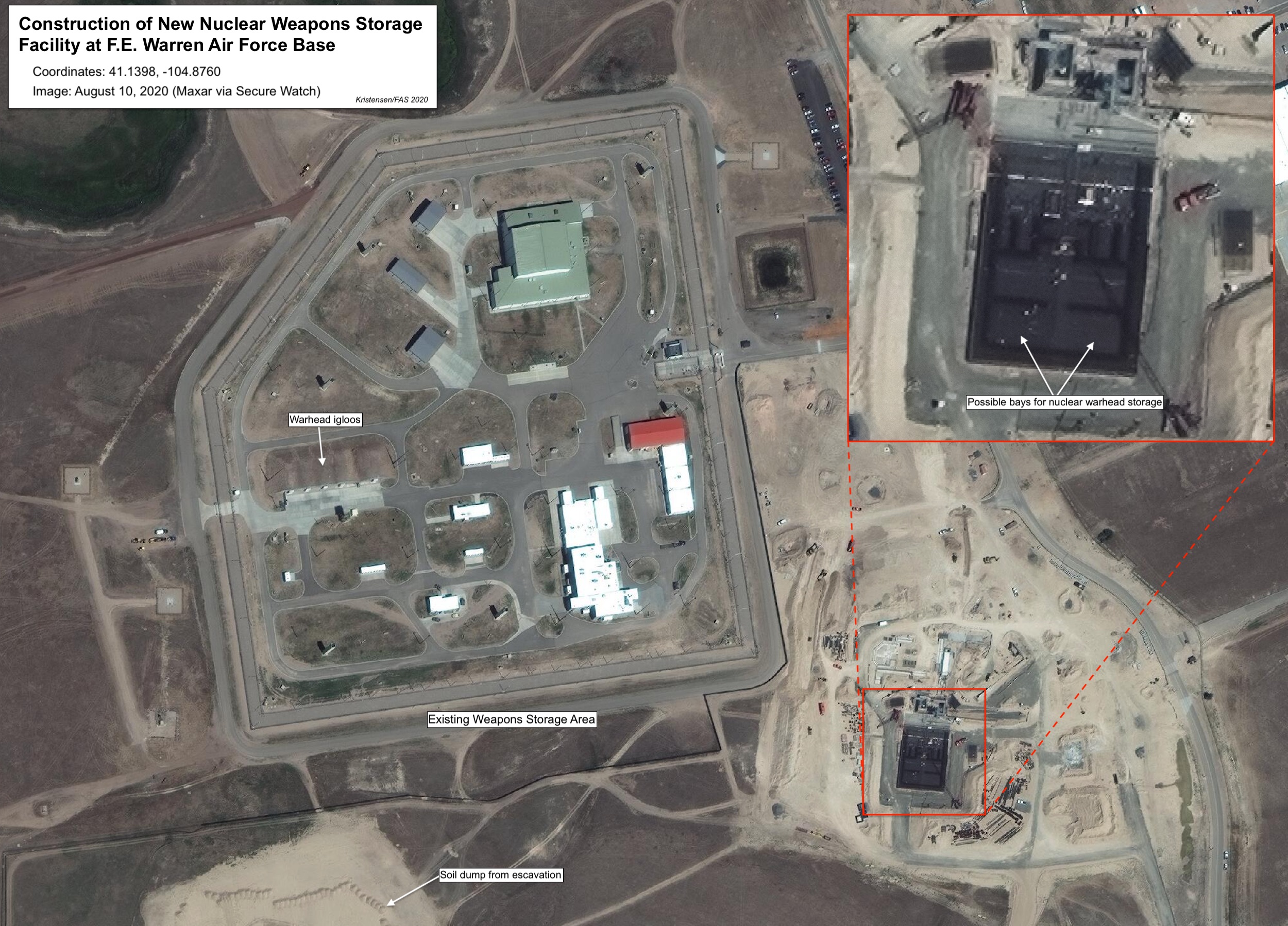
Construction has begun of a new nuclear weapons storage facility at F.E. Warren Air Force Base. Click on image to view full size
The Air Force has begun construction of a new underground nuclear weapons storage and handling facility at F.E. Warren Air Force Base in Cheyenne, Wyoming.
The new Weapons Storage and Maintenance Facility (WSMF; sometimes called Weapons Generation Facility), which will replace the current Weapons Storage Area (WSA), will be a 90,000-square-foot reinforced concrete and earth-covered facility with supporting surface structures.
A satellite image taken in August and obtained from Maxar shows construction is well underway of the underground facility as well as several supporting facilities.
The Air Force says the new facility “will provide a safer and more secure facility for the storage of U. S. Air Force (USAF) assets,” a reference to W78/Mk12A and W87/Mk21 warheads for the Minuteman III ICBMs deployed in Warren AFB’s 150 missile silos. In the future, if Congress agrees to fund it, the new W87-1 warhead will replace the W78. According to the Air Force:
“The primary interior walls of Maintenance and Storage Area are 4-foot thick reinforced concrete (RC) elements with 4-foot thick RC roof slabs. The primary wall and roof elements are surrounded by a 20-foot thick soil layer which is contained by a 3-foot thick RC wall and roof element layer. The heavy multilayered system sits on a 5-foot thick RC structural mat for support.”
The $144 million contract was awarded to Fluor Corporation by the U.S. Army Corps of Engineers in 2018. The ground-breaking ceremony took place on May 21, 2019 but substantial construction (of buildings) did not begin until the Spring of 2020. The president of Flour’s Government Group is Tom D’Agostino, who previously served as the undersecretary for nuclear security at the Department of Energy, administrator of the National Nuclear Security Administration (NNSA), and deputy administrator for defense programs. Construction was scheduled to take 40 months and be completed in 2022.
Construction of the underground storage facility at F.E. Warren AFB follows the completion in 2012 of a massive underground nuclear weapons storage facility at the Strategic Weapons Facility Pacific (SWFPAC) next to the Kitsap Naval Submarine Base. Underground storage facilities are also planned at other bases.
75 Years Ago: The Trinity Nuclear Test
On this day 75 years ago, the world entered the nuclear age. The first ever nuclear detonation – known as the Trinity test – took place in New Mexico on July 16th, 1945. Since then, ten countries built more than 134,000 nuclear weapons. More than 13,400 remain today.
In the decades that followed, nuclear testing contaminated lands, oceans, and people, and triggered a nuclear arms race that continues to this day. The Federation of American Scientists is honored to join our colleagues at the Union of Concerned Scientists and Tularosa Basin Downwinders Consortium in a joint statement with five other U.S. organizations on the humanitarian consequences of nuclear testing, endured by victims in the United States and its Pacific territories, from French nuclear testing in French Polynesia and Algeria, Russian nuclear testing in Kazakhstan, British nuclear testing in Australia, and others.
In addition to these harms, the Trinity test marked the beginning of the global nuclear arms race with its endless cycles of nuclear modernization and competition, which continue to this day. Unlike any other invention, nuclear weapons have the capability to destroy human civilization and much or life on Planet Earth.
The Federation of American Scientists has tracked the rise and fall of global nuclear arsenals for many years. Despite reductions since the Cold War, there are still more than 13,000 nuclear weapons in the world. And we are disappointed to note the emergence of five disturbing trends regarding the current and future state of nuclear weapons:
- Every nuclear-armed country is currently in the midst of modernizing their nuclear arsenals. Some countries are actually increasing their stockpiles, while others are swapping out their older weapons with newer, more effective ones that will endure almost until the end of the 21st century.
- Not only are nuclear arsenals either increasing or improving, but it appears that many states are reinvigorating or even expanding the role of nuclear weapons – specifically tactical nuclear weapons – in their military doctrines. State representatives have often claimed that these deployments are actually intended to prevent conflict; however, regardless of how much stake one puts into that sort of statement, it is a fact that many states are now increasingly posturing themselves for nuclear warfighting. This development will make it more difficult to reduce the role of nuclear weapons and pursue significant reductions – and certainly disarmament – in the future.
- In recent years, we have also seen the decline – and general disinterest – in arms control writ large. Today, bilateral and multilateral arms control agreements have fallen away or are under severe stress, multilateral efforts to engage in good faith arms reductions appear to have completely stagnated, and states often seem more interested in blaming and shaming their prospective arms control partners than actually pursuing measures that would offer a modicum of transparency and predictability in an otherwise unpredictable world.
- Rather than pursue arms control, it seems that states are more content with pursuing arms competition and even arms races. This is a result of renewed military competition and is fueled by the tremendous influence that weapons contractors and lobbyists have on government decisions; indeed, sometimes nuclear decisions seem to be driven as much – if not more – by corporate interests than by national security concerns.
- Nuclear-armed states largely do not appear to consider nuclear disarmament to be an urgent global security, humanitarian, or environmental imperative. Instead, most states seem to consider disarmament as a type of chore mandated by the Non-Proliferation Treaty – and not one that they are seriously interested in completing in the foreseeable future. It is increasingly rare to hear any officials from nuclear weapon states express a coherent rationale for pursuing disarmament other than as a result of the obligation to do so under the Non-Proliferation Treaty. Moreover, they seem increasingly focused on shifting the disarmament responsibility onto the non-nuclear states by arguing they first must create the security conditions that will make nuclear disarmament possible.
Although the Trinity test took place 75 years ago, its destructive legacy continues to this day. And despite these harms, some politicians are even trying to return to an era of live nuclear testing. Resuming nuclear explosive testing would be taking a monumental step backward and would open the floodgates for worldwide resumption of nuclear testing and development of new nuclear weapons. Instead, on this 75th anniversary, we must look forward, try our best to reverse these worrying trends, responsibly reduce the arsenals and the role that nuclear weapons serve, and work towards a world eventually free from nuclear weapons.
The Federation of American Scientists is honored to provide the world with the best non-classified estimates of the nuclear weapons arsenals. We are grateful for the financial support from the New Land Foundation, MacArthur Foundation, Ploughshares Fund, and the Prospect Hill Foundation to do this work. To explore this vast data, developed over many decades, start here: https://fas.org/issues/nuclear-weapons/status-world-nuclear-forces/
The State Department’s Compliance Report Plays the Blame Game, Despite Offering Little Evidence
The State Department’s Bureau of Arms Control, Verification and Compliance yesterday released its annual “Compliance Report,” which provides a detailed overview of US (and other countries’) adherence to various treaty and agreement commitments.
The report’s publication comes at a critical time, as the Trump administration has spent the past few years––and the past three months in particular––dismantling the last vestiges of US commitments to the international arms control regime. The administration has recently declared that it is unlikely to extend New START, has withdrawn from the Open Skies Treaty, has alluded to an intent to resume nuclear testing, and has announced that it will “reinterpret” the Missile Technology Control Regime in order to allow the United States to sell armed drones to previously-forbidden countries.
In addition to its intended purpose––providing the official public US assessment of how other countries adhere to arms control treaties and agreements––the administration clearly sees the Compliance Report as a tool to provide justification for shedding treaties. As such, other countries might question the report’s conclusion that the United States is in full compliance with all of its international obligations, but that other treaty parties are not.
Several sections of the Compliance Report are missing both critical context about how and why certain treaties met their eventual ends, as well as actual evidence for some of its claims about the actions of its arms control partners. To that end, we have tried to fill in some of the blanks below.
The Intermediate-Range Nuclear Forces (INF) Treaty
The report assesses that throughout 2019, the United States was in full compliance with the INF Treaty––the landmark Cold War-era treaty that eliminated and banned all US and Russian ground-launched missiles with ranges between 500 and 5,500 kilometers.
Although this assertion appears to be technically correct and provides an extensive overview of Russian activities, it is missing some critical context. Both the United States and Russia suspended their respective obligations under the treaty in February 2019, and the treaty officially died in August 2019. Although it appeared that Russia had been violating the treaty for many years, we have argued that the Trump administration’s decision to finally kill the treaty was the wrong move, for several reasons.
Firstly, withdrawal established a false moral equivalency between the United States, who probably was not violating the treaty, and Russia, who probably was. It also put the United States in conflict with its own key policy documents like the Nuclear Posture Review and public statements made last year, which emphasized staying in the treaty while trying to bring Russia back into compliance through diplomatic, economic, and military measures. NATO preferred this approach until the Trump administration changed its mind and decided to withdraw, at which point NATO followed suit to avoid being seen to be in conflict with Washington.
The 2020 Compliance Report states that withdrawal from the INF Treaty was intended as a “remedy” for Russia’s material breach. But if the ultimate goal was to coax or coerce Russia back into compliance, then killing the treaty did the opposite. Instead, it legally freed Russia to deploy even more INF missiles on land, something the report explicitly warns that Russia might do by converting the SS-N-30a/Sagaris (Kalibr) sea-launched cruise missile into a land-based system. It also allowed the United States to explore developing INF-range missiles of its own. Only 16 days after the treaty’s collapse, the United States test launched a crudely-fashioned missile that would have certainly violated the INF treaty––if it had still existed.
New START
The 2020 Compliance Report notes that both Russia and the United States are in full compliance with the New START treaty, which caps the number of strategic nuclear warheads and delivery vehicles that each country is allowed to deploy. This is not newsworthy in itself; mutual compliance was confirmed by State and Defense Department officials during Senate testimony in 2018, after the February treaty deadline had passed.
It is bizarre that the Trump administration is using alleged Russian non-compliance with other treaties in order to undermine the one treaty with which Russia is actually complying. Moreover, unlike any other treaty mentioned in the Compliance Report, the strategic forces limited by the New START treaty are the only weapons of mass destruction that can threaten the very existence of the United States.
New START expires in less than a year, and while Russia has agreed to extend it unconditionally, the Trump administration has been dragging its feet. This should be a no-brainer: the treaty is a good deal for both parties, it offers a critical source of predictability and transparency into Russia’s nuclear forces, and extension is widely supported across the country, even among Trump voters; in fact, it’s one of the very few bipartisan issues still remaining in Congress. Senior military leaders, such as the Vice Chairman of the Joint Chiefs of Staff and the commander of Air Force Global Strike Command, have declared their full support for the treaty, largely because it offers a critical source of transparency and stability in the US-Russia nuclear relationship.
Specifically, during the 2018 Senate hearing, then-Under Secretary of State for Arms Control and International Security Affairs noted “The United States benefits from the Treaty’s 18 annual on-site inspections, notifications, and biannual data exchanges, which give us insight into the number of Russia’s strategic offensive arms subject to the Treaty and where they are at any given time.” She further noted, “Should the Treaty expire, U.S. inspectors would lose their current access to Russian strategic nuclear warheads and delivery systems, bases, and infrastructure, as well as the Treaty’s biannual exchange of data and associated updates on the location and status of Russia’s strategic offensive arms subject to the Treaty.” However, this fact hasn’t stopped Trump’s new arms control envoy Marshall Billingslea––an ardent opponent of arms control who opposed US ratification of the 1993 Chemical Weapons Convention and the 1996 Comprehensive Test Ban Treaty, and supported US withdrawal in 2002 from the 1972 Anti-Ballistic Missile Treaty––from inexplicably arguing the opposite point. In an interview with The Washington Times last month, he claimed that “The Obama administration negotiated a very weak verification regime […] which the Russians have been exploiting.” The basis for this claim has not been substantiated by other senior administration or military officials, and is not presented in the Compliance Report itself.
In his recent interview, Billingslea noted that a new or extended New START-style deal would necessarily have to include China. This makes no sense. The entire Chinese arsenal is thought to include about 320 warheads––a fraction of the 4,000-4,500 in the US and Russian arsenals––which is why China’s position has consistently been the same: it will not take part in trilateral arms control negotiations while this strategic imbalance remains.
Therefore, as we have previously argued in Forbes, killing New START because it doesn’t include China would do nothing to address the United States’ security concerns about Chinese nuclear forces. Instead, if limits on US and Russian strategic nuclear forces fell away and caused both countries to increase their nuclear forces, China might decide that it would need to increase its stockpile even further in order to adjust to the greater nuclear threat. This would further exacerbate a post-New START nuclear crisis.
Extension does not require Congressional approval; it simply requires a presidential stroke of a pen. Given that both countries benefit from the treaty, that both countries are in compliance, and that the United States’ NATO allies strongly favor an extension, this is a ripe piece of low-hanging fruit.
The Joint Comprehensive Plan of Action
The JCPOA (commonly known as the Iran Nuclear Deal), is not mentioned at all in the Compliance Report. This is not necessarily surprising, as the Trump administration officially withdrew from––and then violated––the deal in 2018. However, in recent weeks, Secretary of State Mike Pompeo has argued that the United States remains a party to the deal, and therefore could demand a reimposition of sanctions on Iran if an arms embargo is not extended past October. As Senator Elizabeth Warren correctly tweeted in response, “This makes no sense.” “To extend this arms embargo,” she noted, “the Trump admin is suddenly arguing that the US is a party to the same Iran Deal it abandoned.”
Pompeo’s unconvincing argument is undermined by his own former State Department top arms control official, who noted in her 2018 Senate testimony that the United States completed its “withdrawal from the arrangement on May 8.” Additionally, if the Secretary of State truly believed that the United States was still party to the treaty, why would it be excluded from his own department’s comprehensive annual assessment of US treaty obligations?
The absence of JCPOA is even more curious because Iran’s nuclear activities are covered extensively over seven full pages in the Compliance Report.
Nuclear Testing
The Compliance Report does not assess any country’s compliance with the Comprehensive Test Ban Treaty (CTBT) because the United States has not ratified it. The report repeats the Trump administration’s statement that it has no intentions to ratify the treaty, but nonetheless assesses that Russia and China may have conducted nuclear weapons tests that fail to meet the United States’ “zero-yield” standard. This assertion echoes the claims initially made by DIA Director Ashley during his remarks at the Hudson Institute in May 2019.
On Russia, the report states that the “United States assesses that Russia has conducted nuclear weapons-related experiments that have created nuclear yield.” But it adds in the next sentence that the “United States does not know how many, if any [emphasis added], supercritical or self-sustaining nuclear experiments Russia conducted in 2019.” A test that released nuclear energy from a canister would require Russian notification under the Threshold Test Ban Treaty (TTPT), which Russia has not provided. But the Compliance Report does not present any evidence but says additional information is included in a classified annex.
On China, the report is even more vague and circumstantial. It doesn’t explicitly accuse China of having conducted low-yield nuclear tests nor present evidence to that effect. Instead, the Compliance Report says a number of other activities “raise concern” about China’s adherence to the zero-yield standard of the United States and that “the United States cannot rule out the possibility that China could have conducted activities at its test site that are inconsistent with its moratorium commitment…” Details are hidden in a classified annex.
Open source analysists have not detected “any alarming activity” in this regard. Absent public evidence, both China and Russia have rejected the claims, with the Russian Deputy Foreign Minister “[urging] the United States to abandon the growing practice of misinforming the global community about what is happening,” and the Chinese Foreign Ministry spokesperson “[refusing] to dignify the groundless US allegation with a refutation.”
Claims about Chinese and Russian low-yield testing are not new, but are occasionally used by anti-arms control hawks working to hype the Russian or Chinese threat, in addition to pushing for the United States to resume nuclear weapons testing. It is unfortunate that this year’s Compliance Report echoed these claims without offering any public proof to back them up, and that would-be arms control killers are subsequently using them as “evidence” of cheating.
Presidential Nuclear Initiatives
A new addition to this year’s Compliance Report is a large section (three and a half pages) on the 1991-1992 Presidential Nuclear Initiatives (PNIs). This is an oddball because the PNIs were unilateral declaration, not treaties, without any verification. Apparently, including the PNIs is part of the administration effort to make the case that Russia is cheating and therefore can’t be trusted with other treaties such as the New START treaty.
Russia is cheating on one part of the PNIs, the report says, because Russia hasn’t eliminated all nuclear warheads for Ground Forces as it promised in 1991. The report explicitly identifies the SS-21 and SS-26 short-range ballistic missiles (the SS-26 is replacing the SS-21) as dual-capable. The report does not explicitly say Russian ground-forces have retained nuclear artillery, a frequent rumor on the Internet. Curiously, the SSC-8 GLCM is not mentioned in the PNI section, even though it is a ground-launched dual-capable weapon (it is addressed in the INF section of the report).
The big picture, of course, is that Russia has fulfilled most of the PNI promises and significantly reduced its inventory of non-strategic nuclear weapons since the 1990s. The Compliance Report only mentions in passing that “Russia continues to abide by some PNI pledges, such as warhead consolidation and likely the declared reduction in stockpiles…” Although Russia retains more non-strategic nuclear weapons than the United States (up to 2,000 according to the Nuclear Posture Review), that has been the case for the past three decades. Statements by US government officials indicate that Russia reduced its inventory of non-strategic nuclear weapons between 2009 and 2019 by more than one-third.
One thing completely missing from the Compliance Report’s assessment of the PNI issue is that US planned production of a new nuclear sea-launched cruise missile––as recommended by the Nuclear Posture Review––would be in violation of the United States’ own PNI pledge.
The Role of the Compliance Report
Violations of treaties and agreements must be addressed and resolved, which requires a persistent and professional level of engagement with other countries. Because the Trump administration is focused on abandoning treaties and reinvigorating “Great Power Competition” with Russia and China, however, the Compliance Report may increasingly be seen as a means to provide a justification for that agenda.
Even if Russia is cheating on some agreements, that doesn’t mean they will cheat on all of them, or that it is no longer worth it to retain the ones that are working. Russia has a clear interest in limiting US nuclear forces just as the United States and its allies have an interest in limiting Russian forces.
And even though China is slowly increasing its nuclear arsenal, that doesn’t mean that it is necessarily sprinting to parity. Even if the DIA’s projection that China will “at least double the size of its nuclear stockpile” over the next decade were to happen, that would still not bring the inventory anywhere near the size of the US or Russian stockpiles, which are currently estimated at 4,310 and 3,800 warheads, respectively.
There is also an expectation that if China increases its arsenal it will inevitably result in the abandonment of its no-first-use policy. In February, the head of US STRATCOM offered Senate testimony that he “could drive a truck through that no-first-use policy.” But others, such as Gregory Kulacki, have noted that China’s nuclear strategy is more restrained than what the public debate often assumes.
In sum, the annual Compliance Report should function as a way for the United States and its arms control partners to get on the same page about the status of their respective obligations and anticipate where future compliance issues might arise––not as a way to offer justifications for its own misdeeds. Otherwise, its publication may soon contribute to a breakdown in arms control altogether, rather than function as a mechanism to save it.
A Rare Look Inside a Russian ICBM Base
It’s relatively easy to observe Russian missile bases from above. It’s much harder to do it from inside.
But in September, the Russian Ministry of Defense released a rare video of a command exercise which features mobile SS-27 Mod 2 “Yars-S” ICBMs driving around their base near Novosibirsk.
The base itself, which is likely to be the temporary home of the 382nd Guards Missile Regiment, has a relatively strange layout, which makes it significantly easier to identify. Unlike other Yars bases in the 39th Guards Missile Division (which houses the 382nd Regiment)––or even across the region––this base does not have any vehicle garages. Instead, the Yars launchers and support vehicles are simply parked out in the open, usually under camouflage (although they occasionally mix up their camouflage, weirdly replacing the forest green with snowy white well before any snow actually touches the ground!).
The September video shows Russian troops uncovering their ICBMs, taking them out for a spin, and eventually tucking them back in under camouflage blankets.
This regiment––along with the other two Novosibirsk bases associated with the 39th Guards Missile Division––recently completed its long-awaited conversion to Yars ICBMs from its older SS-25 Topol ICBMs. These new missiles are clearly visible in both satellite imagery and in the Ministry of Defense video.
During its conversion, the regiment was moved from its previous base (55°19’2.72”N, 83°10’6.70”E) to this temporary location, while the old base was dismantled in preparation for a substantial upgrade to build new missile shelters for the Yars ICBMs, as well as service and administrative buildings. Construction stalled for several years, possibly because of budget cuts, but has recently picked up again. Once completed, the 382nd Guards Missile Regiment presumably will be relocated back to its old base.
As we write in the Nuclear Notebook, Russia continues to retire its SS-25s at a rate of one or two regiments (nine to 18 missiles) each year, replacing them with newer Yars ICBMs. It is unclear how many SS-25s remain in the active missile force; however, we estimate that it is approximately 54. The remaining two SS-25 equipped divisions will start their upgrades to Yars in 2020, with the SS-25s expected to be fully retired in 2021-2022, according to the commander of Russia’s Strategic Rocket Forces.
Read more about Russia’s nuclear forces in the 2019 Russian Nuclear Notebook, which is always freely-accessible via the Bulletin of the Atomic Scientists.
Mixed Messages On Trump’s Missile Defense Review
President Trump personally released the long-overdue Missile Defense Review (MDR) today, and despite the document’s assertion that “Missile Defenses are Stabilizing,” the MDR promotes a posture that is anything but.
Firstly, during his presentation, Acting Defense Secretary Shanahan falsely asserted that the MDR is consistent with the priorities of the 2017 National Security Strategy (NSS). The NSS’ missile defense section notes that “Enhanced missile defense is not intended to undermine strategic stability or disrupt longstanding strategic relationships with Russia or China.” (p.8) During Shanahan’s and President Trump’s speeches, however, they made it clear that the United States will seek to detect and destroy “any type of target,” “anywhere, anytime, anyplace,” either “before or after launch.” Coupled with numerous references to Russia’s and China’s evolving missile arsenals and advancements in hypersonic technology, this kind of rhetoric is wholly inconsistent with the MDR’s description of missile defense being directed solely against “rogue states.” It is also inconsistent with the more measured language of the National Security Strategy.
Secondly, the MDR clearly states that the United States “will not accept any limitation or constraint on the development or deployment of missile defense capabilities needed to protect the homeland against rogue missile threats.” This is precisely what concerns Russia and China, who fear a future in which unconstrained and technologically advanced US missile defenses will eventually be capable of disrupting their strategic retaliatory capability and could be used to support an offensive war-fighting posture.
Thirdly, in a move that will only exacerbate these fears, the MDR commits the Missile Defense Agency to test the SM-3 Block IIA against an ICBM-class target in 2020. The 2018 NDAA had previously mandated that such a test only take place “if technologically feasible;” it now seems that there is sufficient confidence for the test to take place. However, it is notable that the decision to conduct such a test seems to hinge upon technological capacity and not the changes to the security environment, despite the constraints that Iran (which the SM-3 is supposedly designed to counter) has accepted upon its nuclear and ballistic missile programs.
Fourthly, the MDR indicates that the United States will look into developing and fielding a variety of new capabilities for detecting and intercepting missiles either immediately before or after launch, including:
- Developing a defensive layer of space-based sensors (and potentially interceptors) to assist with launch detection and boost-phase intercept.
- Developing a new or modified interceptor for the F-35 that is capable of shooting down missiles in their boost-phase.
- Mounting a laser on a drone in order to destroy missiles in their boost-phase. DoD has apparently already begun developing a “Low-Power Laser Demonstrator” to assist with this mission.
There exists much hype around the concept of boost-phase intercept—shooting down an adversary missile immediately after launch—because of the missile’s relatively slower velocity and lack of deployable countermeasures at that early stage of the flight. However, an attempt at boost-phase intercept would essentially require advance notice of a missile launch in order to position US interceptors within striking distance. The layer of space-based sensors is presumably intended to alleviate this concern; however, as Laura Grego notes, these sensors would be “easily overwhelmed, easily attacked, and enormously expensive.”
Additionally, boost-phase intercept would require US interceptors to be placed in very close proximity to the target––almost certainly revealing itself to an adversary’s radar network. The interceptor itself would also have to be fast enough to chase down an accelerating missile, which is technologically improbable, even years down the line. A 2012 National Academy of Sciences report puts it very plainly: “Boost-phase missile defense—whether kinetic or directed energy, and whether based on land, sea, air, or in space—is not practical or feasible.”
Overall, the Trump Administration’s Missile Defense Review offers up a gamut of expensive, ineffective, and destabilizing solutions to problems that missile defense simply cannot solve. The scope of US missile defense should be limited to dealing with errant threats—such as an accidental or limited missile launch—and should not be intended to support a broader war-fighting posture. To that end, the MDR’s argument that “the United States will not accept any limitation or constraint” on its missile defense capabilities will only serve to raise tensions, further stimulate adversarial efforts to outmaneuver or outpace missile defenses, and undermine strategic stability.
During the upcoming spring hearings, Congress will have an important role to play in determining which capabilities are actually necessary in order to enforce a limited missile defense posture, and which ones are superfluous. And for those superfluous capabilities, there should be very strong pushback.
The Pentagon’s Annual Report on Chinese Military
[Updated August 21, 2018] The Pentagon’s annual report to Congress on China’s military and security developments has finally been published, several months later than previous volumes. Normally it takes about one month after the report is generated to be published. This year it took three times that long.
The report covers many aspects of Chinese military developments. In this article I’ll briefly review the nuclear weapons related aspects of the report.
Overall, nuclear developments are not what stand out in this report. Although there are important nuclear developments, the Pentagon’s primary concern is clearly about China’s conventional forces.
Nuclear Policy and Strategy
The DOD report repeats the conclusion from previous reports that China has not, despite writings by some PLA officers (and occasional speculations by outside analysts), changed its nuclear policy but retains a no-first-use (NFU) policy and a pledge not to use nuclear weapons against any non-nuclear weapon state or in nuclear-weapon-free zones. That would, strictly speaking, include Japan, even though it hosts large numbers of U.S. forces.
The NFU policy, DOD says, has “contributed to the construction of [underground facilities] for the country’s nuclear forces, which plan to survive an initial nuclear strike.” Stimulants for the tunneling efforts were the 1991 Gulf War and 1999 Kosovo war, which made the Chinese realize how vulnerable their forces would be in a war with the United States.
Nor does the report indicate China has yet mated nuclear warheads to its missiles or placed nuclear forces on alert under normal circumstances. The report repeats the assessment from last that “China is enhancing peacetime readiness levels for these nuclear forces to ensure responsiveness.” That responsiveness is thought to ensure the force can disperse and go on alert if necessary.
The report mentions unidentified PLA writings expressing the value of a “launch on warning” nuclear posture, but it does not say China has adopted such a posture. A launch on warning posture would require high readiness of nuclear forces to be able to launch as soon as a warning of an incoming nuclear attack was received. China already has a “ready the forces on warning” posture that involves gradually raising the readiness level in response to growing tension in a crisis.
In U.S. military terminology, “launch on warning” is a higher readiness level than “launch under attack” because it would involve being able to launch upon detection that an attack was imminent but before incoming missiles had been detected. “Launch under attack,” in contrast, would require the force to be able to launch before incoming warheads hit U.S. launchers. The DOD report says the PLA writings highlight the “launch on warning” posture would be consistent with China’s no-first-use policy, which would imply it is more compatible with a “launch under attack” posture.
The DOD report also continues to describe China’s work on MIRV, the capability to equip missile with multiple independently targetable reentry vehicles. Rather than a sign of an emerging counterforce strategy, however, DOD states that the purpose of the Chinese MIRV program is to “ensure the viability of its strategic deterrent in the face of continued advances in U.S. and, to a lesser extent, Russian strategic ISR, precision strike, and missile defense capabilities.”
Indeed, the counterproductive effects of U.S. ballistic missile defenses on Chinese offensive force developments is clearly spelled out in the report: “The PLA is developing a range of technologies China perceives are necessary to counter U.S. and other countries’ ballistic missile defense systems, including MaRV, MIRVs, decoys, chaff, jamming, thermal shielding, and hypersonic glide vehicles.”
The growing inventory of ICBMs and SSBNs means that China has to improve nuclear command and control of these systems for them to be effective. It is unknown if Chinese SSBNs have yet sailed on a deterrent patrol (we assume not), much less with nuclear warheads onboard (we also assume not). But the growing and increasingly mobile ICBM force is carrying out extensive combat patrol exercises that place new demands on the nuclear command and control system.
A unique feature of the Chinese missile force is the mixing of nuclear and conventional versions of the same missiles (DF-21 and DF-26 have both nuclear and conventional roles). For China, this is a means to provide the leadership with non-nuclear strike options without having to resort to nuclear use. For China’s potential adversaries, it is a dangerous and destabilizing practice that risks causing confusion about the character of missile attacks and potentially trigger mistaken nuclear escalation in a conflict.
China has, like other nuclear-armed states, lowered the yield of its nuclear warheads as ballistic missiles became more accurate. The current warhead used on the DF-31/A ICBMs is thought to be ten times less powerful than the multi-megaton warhead developed for the DF-5. Moreover, as China seeks to ensure the survivability of its warheads against missile defense systems, it is likely to continue to try to reduce the weight and size of its warheads to maximize penetration aids on the missiles.
The DOD report mentions a “defense industry publication has also discussed the development of a new low-yield nuclear weapon,” but does not provide any details about the publication or what it said. The classified version apparently has more details.
The Land-Based Missile Force
The overall number of Chinese ICBM launchers reported by DOD has remained stable since 2011: 50-75. One type (DF-4) has reload capability, so the number of available missiles is a little higher: 75-100 missiles. That number has also remained stable for the past three years. Indeed, other than the arrival of the DF-26 IRBM force, the total Chinese rocket forces estimate is identical to that of presented in the 2017 report.
This indicates that the DF-31A force is not continuing to increase, that the DF-31AG has not yet been operationally deployed (or is replacing older DF-31s on a one-for-one basis), and that the DF-41 is still in development more than 20 years after it was first listed in the annual DOD report.
DOD’s reporting shows that the number of Chinese ICBM launchers has roughly doubled since 2003, while the number of missile available for those launchers has more than doubled. The numbers of missiles show a mysterious increase in 2016 from just over 40 to more than 80 (see table below). The increase is curious because it does not follow the number of launchers but suddenly jumps even though there was no corresponding increase in launchers that year.
The DF-4 is thought to have reloads but that system has been deployed since the 1980s. There is considerable uncertainty in the number of launchers (some years 25). The increase coincides with the deployment of the MIRVed DF-5Bs, so a potential explanation might be that there are two full sets of DF-5 versions. But it should be underscored that it is unknown if this is the reason.
The old liquid-fuel DF-4 (CSS-3) ICBM is still listed as operational, even though the relocatable missile will probably be replaced by more survivable road-mobile missiles in the near future. The DF-4 appears to be retained in a roll-out-to-launch posture.
The old, but updated, liquid-fuel, silo-based DF-5 ICBM is still listed in two version: the single-warhead DF-5A and the MIRVed DF-5B. This missile was first deployed in the early-1980s and is based in 20 silos in the eastern part of central China. There is no mentioning of a rumored C version.
The DF-31 and DF-31A are the most modern operational ICBMs in the Chinese inventory. First fielded in 2006 and 2007, respectively, deployment of the DF-31 appears to have stalled and DF-31A is operational in perhaps three brigades. Each missile can carry a single warhead. The DF-31AG is mentioned for the first time as an enhanced DF-31 with improved launcher maneuverability and survivability but may not yet be fully operational.
The long-awaited DF-41 ICBM remains in development and is listed by DOD as MIRV-capable. The report states that China is “considering additional launch options” for the DF-41, including rail-mobile and silo-basing. In silo-based version it would likely replace the DF-5.
The medium- and intermediate-range nuclear missile force is made up of three types: the new DF-26 IRBM, which is dual-capable and able to conduct conventional (both land-attack and anti-ship) and nuclear precision attacks; and two versions of the DF-21: DF-21A and DF-21E. The DF-21 A (SSC-5 Mod 2) has been deployed since the late-1990s. The DF-21E (note: the E designation is not official but assumed) is known as the SSC-5 Mod 6 and was first reported in 2016. The DF-21 also exists in two conventional versions: DF-21C and DF-21D (anti-ship).
The dual-capable DF-26, first fielded in 2016, is capable of conducting “nuclear precision strikes against ground targets.” There appears to be one or two DF-26 brigades.
The role of the new Strategic Support Force is listed as intended to “centralize the military’s space, cyber, and EW [Early Warning] missions. These would probably support the rocket force.
The Submarine Force
The DOD report says that China still operates four Jin-class (Type 094) SSBNs (all based at Hainan), each of which can carry up to 12 JL-2 SLBMs. At least one more Jin-SSBN is said to be under construction. Construction of a new SSBN (Type 096) may begin in the mid-2020s with a new SLBM (JL-3). DOD speculates that Type 094 and Type 096 SSBNs might end up operating concurrently, which, if accurate, could increase the size of the total SSBN fleet.
China also operates five Shang-class (Type 093/A) nuclear-powered attack submarines, with a sixth under construction. The Shang has now completely replaced the old Han-class (Type 092). DOD anticipates that a modified Shang (Type 093B) equipped with land-attack cruise missiles may begin building in the early-2020s. [Note: while many public sources call the two existing Shang versions Type 093A and Type 093B, the DOD report calls them Type 093 and Type 093A. The Type 093B is listed as a future type that until 2016 was called Type 095.]
Overall, China operates 56 submarines, of which 47 are diesel-electric. The report projects this force may increase to 69-78 submarines by 2020, a significant increase in only two years.
There is no mentioning in the DOD report of the nuclear sea-launched cruise missile listed in the Nuclear Posture Review fact sheet from February 2018.
The Bomber Force
One of the most interesting nuclear developments in the DOD report is the assessment that “the PLAAF has newly been re-assigned a nuclear mission.” This contrasts with last year’s report, which stated the “PLAAF does not currently have a nuclear mission.” The “re-assignment” indicates that the bombers previous had a nuclear mission. We have estimated that a small number of bombers had a dormant nuclear capability for gravity bombs as indicated by their extensive role in the nuclear weapons testing program and China’s display of nuclear bombs in military museums.
The DOD report states that the H-6 and the future stealth bomber could both be nuclear-capable. The future bomber, according to the DOD report, could potentially be operational within the next ten years.
The report repeats the estimate made by the U.S. Intelligence Community from the past two years that China is upgrading its aircraft with two new air-launched ballistic missiles, one of which may include a nuclear payload.
The DOD report does not mention the nuclear air-launched cruise missile listed the Nuclear Posture Review fact sheet from February 2018.
Additional Background:
Pentagon Report: China Deploys MIRV Missile
By Hans M. Kristensen
The biggest surprise in the Pentagon’s latest annual report on Chinese military power is the claim that China’s ICBM force now includes the “multiple independently-targetable re-entry vehicle (MIRV)-equipped Mod 3 (DF-5).”
This is (to my knowledge) the first time the US Intelligence Community has made a public claim that China has fielded a MIRVed missile system.
If so, China joins the club of four other nuclear-armed states that have deployed MIRV for decades: Britain, France, Russia and the United States.
For China to join the MIRV club strains China’s claim of having a minimum nuclear deterrent. It is another worrisome sign that China – like the other nuclear-armed states – are trapped in a dynamic technological nuclear arms competition.
A Little Chinese MIRV History
There have been rumors for many years that China was working on MIRV technology. Some private analysts have even claimed – incorrectly – that China had developed MIRV for the DF-31 ICBM and JL-2 SLBM.
Fifteen years ago, CIA’s National Intelligence Estimate on foreign missile developments concluded that “China has had the technical capability to develop multiple RV payloads for 20 years. If China needed a multiple-RV (MRV) capability in the near term, Beijing could use a DF-31-type RV to develop and deploy a simple MRV or multiple independently targetable reentry vehicle (MIRV) for the CSS-4 in a few years.” (For a review of earlier information and assessments, see here.)
The Pentagon echoed this conclusion in July 2002, when it stated that any Chinese multiple warhead capability will “most likely [be] for the CSS-4.”
Chinese MIRVing of a mobile ICBM such as the DF-31 “would be many years off” the CIA told Congress. This was also the conclusion of the CIA’s National Intelligence Estimate in 2001, which concluded that “Chinese pursuit of a multiple RV capability for its mobile ICBMs and SLBMs would encounter significant technical hurdles and would be costly.”

A DF-5 ICBM is launched from a silo. The Pentagon says China has equipped some of its DF-5s with MIRV.
In an exchange with Senator Cochran in 2002, CIA’s Robert Walpole explained that MIRVing a mobile ICBM would require a much smaller warhead and possibly require nuclear testing:
Sen. Cochran. How many missiles will China be able to place multiple reentry vehicles on?
Mr. Walpole. In the near term, it would be about 20 CSS-4s that they have, the big, large ICBMs. The mobile ICBMs are smaller and it would require a very small warhead for them to put multiple RVs on them.
Sen. Cochran. … [D]o you think that China will attempt to develop a multiple warhead capability for its new missiles?
Mr. Walpole. Over time they may look at that. That would probably require nuclear testing to get something that small, but I do not think it is something that you would see them focused on for the near term.
What makes the Pentagon’s report on the MIRVed DF-5A payload noteworthy is that it was not included in several other intelligence assessments published in the past few months: the prepared threat assessment by the Director of National Intelligence; the prepared threat assessment by the Defense Intelligence Agency; and STRATCOM’s prepared testimony.
Nor were a MIRVed DF-5A mentioned in the Pentagon’s report from 2014 or the Air Force National Air and Space Intelligence Center (NASIC) report from July 2013.
The Pentagon report also repeats an earlier assertion that “China also is developing a new road-mobile ICBM, the CSS-X-20 (DF-41), possibly capable of carrying MIRVs.” STRATCOM commander Admiral Cecil Haney also mentioned this, saying China is “developing a follow-on mobile system capable of carrying multiple warheads.”
“Possibly capable of” and “capable of” are not equal assessments; the first includes uncertainty, the second does not. Assuming CIA’s prediction from 15 years ago is correct, the DF-5 MIRV payload might consist of three warheads developed for the DF-31/31A.
Whatever the certainty, the MIRVed version of the DF-5 – which I guess we could call DF-5B – is not thought to be loaded with warheads under normal circumstances. In a crisis, the warheads would first have to be brought out of storage and mated with the missile.
Moreover, The Pentagon lists two versions of the DF-5 deployed: the DF-5A (CSS-4 Mod 2) and the new DF-5 MIRV (CSS-4 Mod 3). So only a portion of the 20 missiles in as many silos apparently have been equipped for MIRV.
Why Chinese MIRV?
The big question is why the Chinese leadership has decided to deploy MIRV on the silo-based, liquid-fuel DF-5A.
Chinese officials have for many years warned, and US officials have predicted, that advanced US non-nuclear capabilities such as missile defense systems could cause China to deploy MIRV on some of its missiles. The Pentagon report repeats this analysis by stating that China’s “new generation of mobile missiles, with warheads consisting of MIRVs and penetration aids, are intended to ensure the viability of China’s strategic deterrent in the face of continued advances in U.S. and, to a lesser extent, Russian strategic ISR, precision strike, and missile defense capabilities.”
Conclusions
Chinese MIRV on the DF-5 ICBM is a bad day for nuclear constraint.
Seen in the context of China’s other ongoing nuclear modernization programs – deployment of several types of mobile ICBMs and a new class of sea-launched ballistic missile submarines – the deployment of a MIRVed version of the DF-5 ICBM reported by the Pentagon’s annual report strains the credibility of China’s official assurance that it only wants a minimum nuclear deterrent and is not part of a nuclear arms race.
MIRV on Chinese ICBMs changes the calculus that other nuclear-armed states will make about China’s nuclear intensions and capacity. Essentially, MIRV allows a much more rapid increase of a nuclear arsenal than single-warhead missile. If China also develops MIRV for a mobile ICBM, then it would further deepen that problem.
To its credit, the Chinese nuclear arsenal is still much smaller than that of Russia and the United States. So this is not about a massive Chinese nuclear buildup. Yet the development underscores that a technological nuclear competition among the nuclear-armed states is in full swing – one that China also contributes to.
Although it is still unclear what has officially motivated China to deploy a MIRVed version of the DF-5 ICBM now, previous Chinese statements and US intelligence assessments indicate that it may be a reaction to the US development and deployment of missile defense systems that can threaten China’s ability to retaliate with nuclear weapons.
If so, how ironic that the US missile defense system – intended to reduce the threat to the United States – instead would seem to have increased the threat by triggering development of MIRV on Chinese ballistic missiles that could destroy more US cities in a potential war.
The deployment of a MIRVed DF-5 also raises serious questions about China’s strategic relationship with India. The Pentagon report states that in addition to US missile defense capabilities, “India’s nuclear force is an additional driver behind China’s nuclear force modernization.” There is little doubt that Chinese MIRV has the potential to nudge India into the MIRV club as well.
Indian weapons designers have already hinted that India may be working on its own MIRV system and the US Defense Intelligence Agency recently stated that “India will continue developing an ICBM, the Agni-VI, which will reportedly carry multiple warheads.”
If Chinese MIRV triggers Indian MIRV it would deepen nuclear competition between the two Asian nuclear powers and reduce security for both. This calls for both countries to show constraint but it also requires the other MIRVed nuclear-armed states (Britain, France, Russia and the United States) to limit their MIRV and offensive nuclear warfighting strategies.
This publication was made possible by a grant from the New Land Foundation and Ploughshares Fund. The statements made and views expressed are solely the responsibility of the author.
